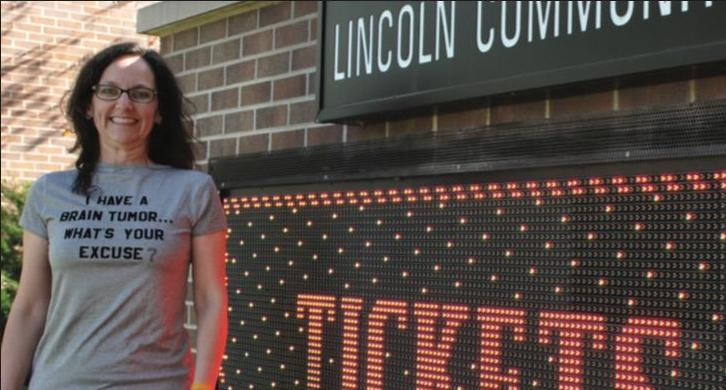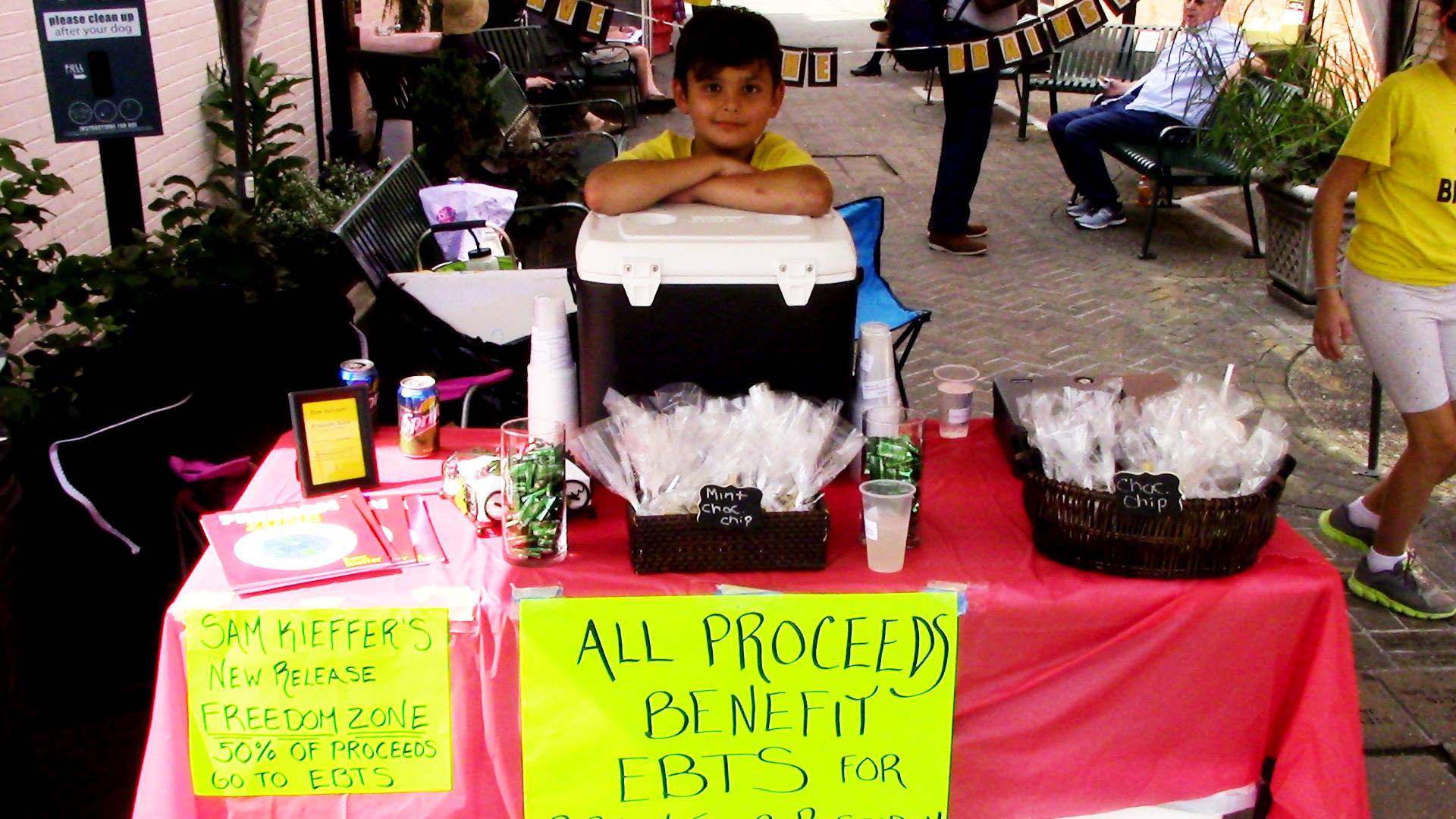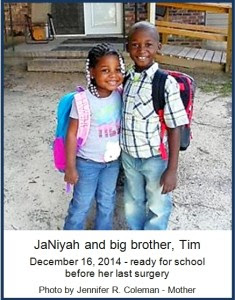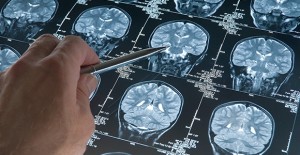2020
May
Dear EBTS members and friends of EBTS,
This last year has been filled with incredible accomplishments for the EBTS community that wouldn’t have been possible without you!
To bring you up to date, the Epidermoid Brain Tumor Society is entering into a research partnership with Manuel Ferreira, Jr. MD, PhD at the University of Washington Medical Center (UWMC). Dr. Ferreira serves as the Chief of Neurological Surgery and the Director of Skull Base Neurosurgery at the University of Washington, a program that spans 3 hospitals including the UWMC, Harborview Medical Center and Seattle Children’s Hospital.
You are the key for research for the epidermoid brain tumor. Make your online donation to continue progress in care, research, and advocacy in 2020! http://
Don’t miss this opportunity to help research for the epidermoid brain tumor.
“Keep on keeping on”,
Epidermoid Brain Tumor Society Board
2019
December
RESEARCH!
We are happy to announce we now have a researcher! Dr. Manuel Ferreira in Washington State! He has donated tissue from 20 patients, and dna from both their parents to find a variant that may cause our tumors. We are fundraising for this specific research now! We hope the study will begin in 2020! Please join us in this mission of ours!! Epidermoidbraintumorsociety.org/donate. https://www.uwmedicine.org/bios/manuel-ferreira
August
Reseach!
EBTS is a non-profit organization for the education, awareness, support of our members, and fundraising for research! We hope you find much support and information here and on our Facebook page! If you have been helped, we ask you consider donating to our research fund. We are currently looking at a new study, that will study epidermoid brain tumor only! Please join with us as we are closer to having a real research study on the origin of these terrible tumors! Donations of any amount are very welcome. Note Paypal takes a % of the amount you give, we do not receive the full amount. There is also an address to mail a check if you desire. We are getting so close to research, please help us with our mission! More details to come!!
epidermoidbraintumorsociety.org/donate
June
Every Support Group Needs a Sam!-Another celebrity in our midst!
Sam Kieffer and his family are EBTS Heros! Here is an article written by his mother Terri and EBTS admin Fay Powell. Fay wrote this for our Facebook page: The IBTA’s Brain Tumour magazine is published annually (approximately 14,000 copies) and free to recipients in 111 countries and widely distributed. Interviews with eminent neuro oncologists, neurosurgeons, researchers, specialist nurses and allied healthcare professionals from around the world; stories from brain tumour patients and carers; information on new approaches to treatment; news from our international brain tumour community; reports of activities held during the International Brain Tumour Awareness Week and the Walk Around the World for Brain Tumours and our global directory of brain tumour patient and carer support groups. In this year’s issue, 2019, an article about member, Terri Kieffer’s son, Sam Kieffer, Pennsylvania, age 10, and his good work for Epidermoid Brain Tumor Society is included. Go to Pages 59 – 61 and read about Sam.
April
Member recently had TN surgery for pain. Here is some information for these surgeries:
Trigeminal Nerve Pain minimal invasive surgery option information: http://face-facts.org/treatments/neuralgia-treatments/procedures/rhizotomies/
https://www.mayfieldclinic.com/PE-PSR.htm
Alternative Therapies Summary by one of our trusted members:
Hello fellow members !
I wanted to share some recent information and hope it could be interesting, hopeful, and helpful to many.
To give some background, I have seen many neurosurgeons over the years for consultation and only Dr Michael McDermott at UCSF suggested radiation as part of my treatment plan. (In fact several neurosurgeons I saw were very anti-radiation and stated surgery is the only treatment). As we all know, this tumor has the best chance of removal on the first pass and if not completely removed you will end up with a lifetime of repeat surgeries. (Dr. McDermott did not do my two surgeries although I had consulted him prior to my first one, 12 years ago!) He has had many epidermoid patients over his decades in practice. He and many other neurosurgeons/radiation oncologist have been thinking about how to reduce the whole life risk of repeat surgeries to epidermoid patients and technology has finally caught up!
Radiotherapies and radio surgeries are now being done for the epidermoid tumor (as they have been for years for other skull base benign tumors)!
This may be an option for some of us who don’t want to have more surgeries/can’t have more surgeries and the tumor keeps growing.
I have been having progressively worse symptoms since 2016, with diplopia and fatigue and headaches. I have decided to put off surgery as long as possible. After Dr. McDermott suggested I meet with a radiation oncologist (he has been recommending this for the last 3 years for me), I decided to finally make the appointment and prior to going I did as much pubmed reading and reaching out to colleagues as I could, to learn more.
After what I’ve learned about radiotherapy, I have decided I will mostly likely have radiotherapy done and completely bypass a 3rd surgery. I know a 3rd surgery won’t remove everything and then I’ll be stuck needing another surgery or radiation anyway afterwards. I’ve decided to just opt for the risks of radiotherapy at this time, for many reasons.
Here are some terms to help you understand radiotherapy (RT)/radiosurgery:
Typical side effects I’ve learned are: hair loss at location of beam focus, and depending on the location of your tumor, you could have some cranial nerve defects (hearing apparatus very sensitive, as is pituitary and visual areas). Fatigue is common during treatment. Of course, there is a risk 20-30years down the line of another tumor because of the brain radiation but I’ve read and I’ve been told it’s often another benign tumor, like a meningioma. Of course a malignant brain tumor can also happen. The risk of brain necrosis is very low with a low dose in general and increases w/ increased dose intensity.
Here are some general terms and definitions if anyone decides to investigate the radio surgery or radiotherapy route.
The main two types I’ll cover are are:
1. photons (X-rays, pass through tissues, almost all radiation is w/ photons )
2. protons (positive particles which enter at a high dose and end at tumor edge)
Conventional fractionated radiotherapy : small doses daily over several weeks . Fractionated means they break up the total dose they would like to deliver into smaller daily doses. This is best for irregularly shaped tumors and if they would like for a larger margin of error, which would encompass cells that may be hiding a little bit off or if the margins of the tumor aren’t very clear (especially if there is a lot going on w/ scar tissues, etc). I read from a review that there didn’t seem to be a difference between 50-60 gys (gray) total intensity exposure but that less than 50 grays, there was higher recurrence of the tumor. Also at a dose of 60 Gys or more, there are a lot more side effects. Lower gys are used if close to hearing or visual apparatuses due to likelihood those would get impacted. Long term survival rates and progress-free survival was relatively high, some reports >90%. The biggest predictors of worse outcomes is location and size of tumor. From my understanding, there is conventional radiotherapy (that is 2D), 3D conformal radiation therapy (more advanced but still considered also an old technology as the high dose area doesn’t carve out normal tissues), and now there is IMRT (intensity modulated radiotherapy) which is even more advanced 3D conformal RT. IMRT draws out the tumor and normal tissues and uses computer algorithms to find best beam angles and move beam blocks in the machine to carve out normal tissues and maximize dose to only the tumor.
There is also cyberknife and gamma knife, which is more accurate (1-2mm accuracy) vs 3-4mm accuracy of standard IMRT. They require special immobilization techniques to ensure accurate dose delivery w/in 2 mm. Cyberknife and gamma knife usually hypo-fractionate (using more than 2 Gys per day, usually between 2.5Gy per day to 34Gys in a day). Higher dosages can just be done faster (within one to a few days) and overall uses less intensity. I was told 50grays in 2 gy fractions over 25 days is equivalent to a dose of 16-20gys over one day.
Protons beam therapy is used in pediatric cases, to prevent developmental delay or toxicity (its a less of an issue in adults who have an already developed brain). The proton radiation can enter at a higher dose than photons, but they stop at the end of the tumor edge (no exit dose, different from Xrays that pass through). Proton therapy is often not covered by insurance and it is only offered at a few center now because the machine costs >$100million. I was told by two rad oncs that proton beam therapy is just not quite nuanced and precise yet, and depending on where you go, positioning can be less accurate or not dependable. Proton beams can have an high dose of entrance radiation which falls off rapidly but there are more cases of brain necrosis (which can sometimes be not problematic).
The type of radiotherapy/radiosurgery you are offered really depends on your tumor shape/characteristics and location of tumor, but I was told that for this tumor it is better to have a larger margin of error just to really be sure we get all the epidermoid cells and prevent future regrowth and need for future surgery (I thus was recommended to have IMRT by 1 Rad Onc doc I saw, and another Rad Onc friend I’ve been emailing. Please note everyone is different but I’ve had 2 surgeries, have an irregularly shaped mass at my CP angle, many cranial nerves are encased, and have titanium mesh in my skull. Cyberknife and gamma knife are not options for me, and I’ve decided proton beam isn’t an option either for me).
I personally spoke to Dr Tierney reviewed my MRI as well. His ultrasound focused (FUS) therapy is only approved at this time for essential tremors. He has used it successfully for a pediatric patient with a hamartoma tumor. He said that CP angle tumors just are not accessible at this time with FUS technology as they are too low in the skull and if he (or anyone) were to employ this form of treatment, as it heats the bone. There is also the risk of cavitation and boiling cells within brain which would not be a good thing! He is working on a safety study and his teams’ contact is here : [email protected]. Dr. Tierney is a neurosurgeon and Phd and welcomes emails to [email protected]. You can inquire if you or any other tumor is treatable but it appears that there is only application for the upper CP angle and he emphasizes that the use of FUS for epidermoid is more theoretical at this time. For more information on FUS technology see https://www.fusfoundation.org/
March
Winn has an epidermoid and sings beautifully after her surgery! https://www.facebook.com/lukebryan/videos/258870575023728/?__tn__=%2CdkCH-R-R&eid=ARAfpNprDXC_WBhl-_VSbKTOISVxsxgocddZjtFWysI7L-9Rwg7ofPI2iJhNObcKlV8jJ1372rGh2jTM&hc_ref=ARS1EXnd98WJyH8-_8WtnWuZ3vFSM7ADXLIzJIe38BZTLNiBt9M0HKzItd84TK_RrHA&fref=nf&hc_location=group
February
A Celebrity in Our Midst!
We have another celebrity in the Epidermoid Brain Tumor Society. EBTS’s administrator, Deb Waechter, Nebraska, was chosen for Madonna Rehabilitation Hospital yearly calendar 2019. She is featured in the month of November. Deb had surgery for the epidermoid brain tumor in 2014. She experienced multiple complications, including a brain bleed, meningitis, and cranial nerve injury. She had time away from her family in Madonna Rehabilitation Hospital almost 8 weeks and then endured many months of therapy to overcome her deficits. She can now walk, eat, swallow, and talk again, even changing her career and going back to school. Deb graduated in December with a Human Services Degree. Deb is back to running, her favorite hobby! Congratulations, Deb, you are our inspiration and our hero! We wish you the best!! The Lincoln Journal Star featured Deb with her story:
‘I have a brain tumor. . .what’s your excuse?’ Stories of hope from Madonna Rehab Hospital
by CINDY LANGE-KUBICK Lincoln Journal Star
Deb Waechter poses for a photo that appears in next year’s Madonna Rehabilitation Hospital calendar. The words were printed on the back of her shirt.
Deb Waechter wore it that Saturday in 2014, the first Good Life Halfsy, when she ran 13.1 miles just 10 months and a day after surgeons sewed her head back up.
A photo of Waechter wearing that running shirt is on next year’s Madonna Rehabilitation Hospital’s calendar. The 50-year-old mother of two is standing in front of the Lincoln Community Playhouse, her gray T-shirt telling her story in big black letters: “I have a brain tumor. . . What’s your excuse?”
The photographer had her put it on backwards, Waechter said last week. It made sense. She no longer needed Halfsy runners to see why she was making her way slowly – but surely – toward the Haymarket.
But Madonna needed its patients to see what was possible.
It’s been a decade since Madonna first started printing its wall calendar, a combination holiday card to supporters and staff and an inspirational marker of time that hangs in every patient’s room.
Each month features a former patient – young and old, stroke patients, patients with brain injuries from car accidents, spinal cord injuries – living their lives.
It motivates current patients, said Tami Rudder, Madonna’s marketing, media and public relations specialist. Many use it to cross off the days until their release. Then the calendar goes home, Rudder said. And a new one is hung in its place.
* * *
Deb Waechter’s moment in the Madonna spotlight comes in November.
“That picture is all Deb,” said Gail Finsand, a speech language pathologist at Madonna. “She came in with such a bright spirit.”
Finsand worked with Waechter after she was released from inpatient care at the rehabilitation hospital in Lincoln in March of 2014. She’s the person who alerted Rudder to her former patient and her exceptional spirit.
“She had such a commitment to recovery,” she says. “These patients really have to commit to a home program and she absolutely did.”
Waechter’s brain tumor had been benign but potentially deadly. A rare and slow-growing tumor called an epidermoid that she’d likely had since before birth.
“It’s not a good thing to have in your head,” Waechter said.
And it was beginning to press on her brain stem and make its presence known.
She’d developed double vision. She’d noticed her legs and feet losing feeling and strength. She tripped on carpet. Stumbled and turned into walls. But she figured it was fatigue from running. Or clumsiness. Or her habit of always being in a hurry.
When her sight didn’t improve, she was referred to a specialist who made the diagnosis. She prepared her will.
Her seven-hour surgery at the University of Nebraska Medical Center in Omaha went well. The complications came later. She developed a brain bleed and needed an emergency intubation. All of her cranial nerves were stretched. She had a paralyzed vocal cord and swallowing was nearly impossible.
A five-day stay turned into three weeks, followed by a month at Madonna, followed by more months of outpatient treatment.
Waechter started her stay in the stroke unit. She had to learn to walk again, to swallow, to talk above a whisper. It was six months before her feeding tube was removed.
Her goal: To eat at her daughter’s high school graduation. She did.
She returned to her old job in finance, but it was too much. She couldn’t sing in musicals. She couldn’t run without wearing out. She still struggled with double vision. It took time and more than just showing up for her therapy.
“I think she really saw that the therapist can help me set the course, but I am the one who ultimately has to do it,” Finsand, her speech therapist said.
And she did.
“She took it a day at a time and she was grateful for each step in her progress.”
When Madonna asked her to pose for its calendar, Waechter answered a long list of questions about her therapy and recovery. She wrote about her challenges and her blessings. Going back to college (she graduated this month with an associate’s degree in human services from Southeast Community College). Helping coach new runners. Helping out at the Community Playhouse, auditioning for roles again.
“I have traveled some and enjoy each and every moment I am blessed to wake up on this earth,” she wrote.
Her two kids are grown up now. John Mason is 24. Emma Louise is 22. She has a part-time job at the front desk at the Legacy Estates on Van Dorn Street that she loves.
Her husband, Matt, and her children and her family got her through, she says. And so did UNMC and Madonna.
“I will be indebted to them forever.”
She gives herself a little bit of credit, too.
“To me attitude is everything. I knew the only way to overcome any of this was to work my butt off.”
* * *
2018
SHOPPING BENEFITS EBTS!!
Shop Amazon at smile.amazon.com and look for Epidermoid Brain Tumor Society, and Amazon will donate 1/2% of your purchase amount to EBTS.
https://smile.amazon.com/gp/f.htmlC=YHPN87VVYJ79&K=2O1WXNFLI2QDQ&M=urn:rtn:msg:20181107150310b40036622ec547d79fbbbb327c20p0na&R=ATHX8G0AI9YF&T=C&U=http%3A%2F%2Fsmile.amazon.com%2Fch%2F46-2856696&H=DZL9PX7BQHMMRFKIUX0RPUGIGAQA
Our Own Cover-girl!!
We have a cover-girl in the EBTS organization!! Congratulations! 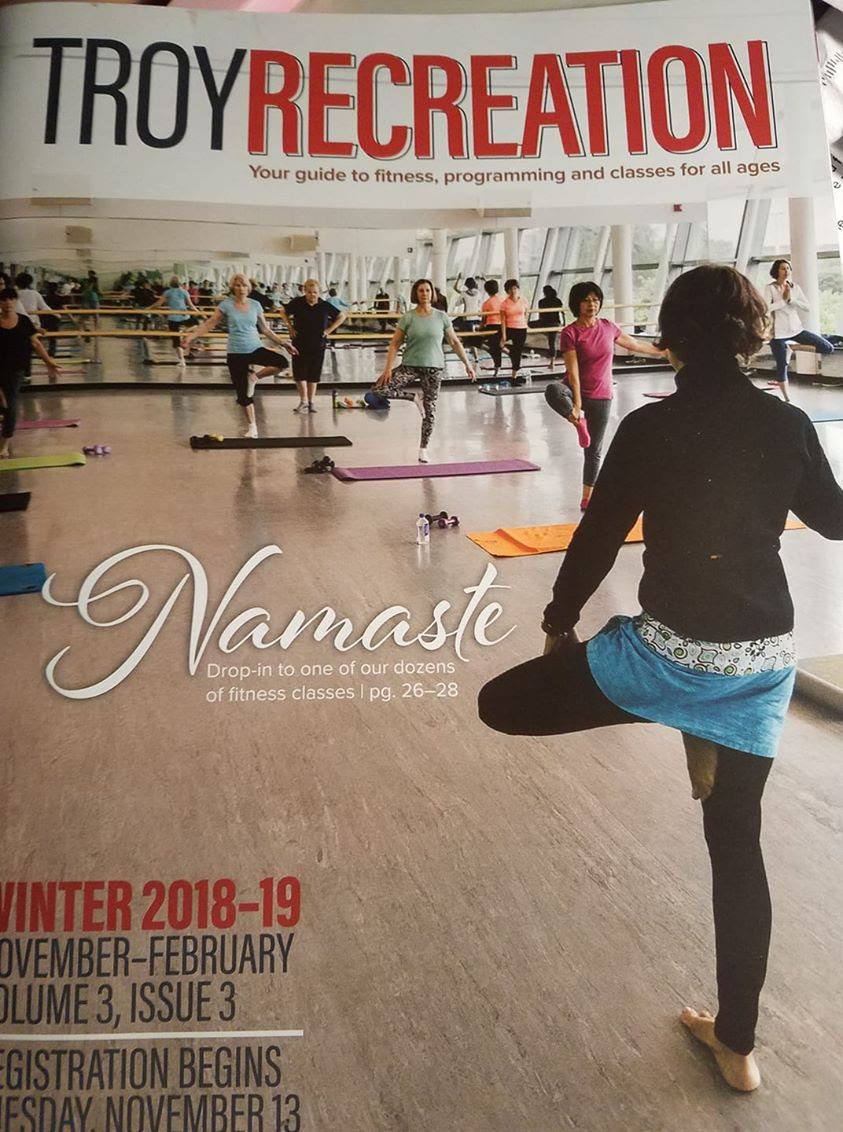 Our own Ilene A. Karagozian-Hill leading her fitness class at Troy Recreation. Ilene is a survivor of six brain surgeries. She was misdiagnosed for years and had five brain surgeries for treatment with no improvement and conditions worsening. Even though her insurance provider resisted, Ilene flew to North Carolina for one more surgery from a world renowned skull base neurosurgeon, Dr. Takanori Fukushima, Carolina Institute Neuroscience, Raleigh, N. C., USA. She has been one “tough cookie” dealing with wrong diagnosis and too-quick recommendations from doctors to uncooperative insurance companies. Ilene writes in her autobiographical book of a knock-down, drag-out fight with her insurance company denying much needed coverage before she finally got the surgery needed, performed by the one neurosurgeon she trusted. My class made the cover of the new Magazine!! See her personal story here
Our own Ilene A. Karagozian-Hill leading her fitness class at Troy Recreation. Ilene is a survivor of six brain surgeries. She was misdiagnosed for years and had five brain surgeries for treatment with no improvement and conditions worsening. Even though her insurance provider resisted, Ilene flew to North Carolina for one more surgery from a world renowned skull base neurosurgeon, Dr. Takanori Fukushima, Carolina Institute Neuroscience, Raleigh, N. C., USA. She has been one “tough cookie” dealing with wrong diagnosis and too-quick recommendations from doctors to uncooperative insurance companies. Ilene writes in her autobiographical book of a knock-down, drag-out fight with her insurance company denying much needed coverage before she finally got the surgery needed, performed by the one neurosurgeon she trusted. My class made the cover of the new Magazine!! See her personal story here
October 2018
Congratulations Sam and ‘Save the Brains’ Campaign!
Sam and his family have raised $3300.20 this fall for EBTS!
In 2016, EBTS member, Terri DiLeo Kieffer, Pa., US, joined the Epidermoid Brain Tumor Society to gain support and information for her husband, Kenny, diagnosed with the rare epidermoid brain tumor. Kenny Kieffer has had surgery twice for the epidermoid brain tumor. The epidermoid brain tumor is a recurrent tumor, and if not totaled at first surgery will reoccur again. At the time of the second surgery, the Kieffer’s oldest son, Sam, was only seven, but he realized then that the epidermoid may grow again after resection. He was told that there is no research for the epidermoid brain tumor, and there are no treatments other than undergoing multiple brain surgeries. He was devastated by this news and understood that the epidermoid brain tumor needed research. Sam with help from his mother, Terri, created a gofundme page which featured a hand written letter asking for help. Sam’s gofundme page was very successful in securing donations for EBTS. This gives much satisfaction to Sam but not stopping there, he has embarked on setting up a roadside lemonade and treat stand at various events. At one event set up. a traveling motorcyle group stopped and aided Sam and his team with volunteer help and donations. Sam, now nine years of age, with his team has raised over $7,000 in funding (by the end of 2017) for epidermoid brain tumor research since he has launched his campaign gofundme page and traveling lemonade and treat stand. EBTS thanks the Kieffer family, their extended family of the Kieffer’s, and their friends in the community for their awesome efforts in supporting EBTS in the search to fund specific research for the epidermoid brain tumor.
Recently Sam introduced himself with a word to his supporters on his special facebook page, Save the Brains.
Hello everyone! I’m Samuel Kieffer, and I am the head of Save The Brains. Now I started out not knowing what was going on with my dad, but I was informed he had a rare brain tumor. I was also told there was no cure. I wanted to help! I started organizing fundraisers for it. Thus began the greatest journey ever, the journey to Hogwarts. Just kidding!! Sorry but I had to add some humor. Anyway, thus began Sam’s Save The Brains!!! I started with a small gofundme page, then I passed my goal and moved on to bigger and better things like a lemonade stand. When business started booming, I thought we needed to go further then just a lemonade stand. I decided to add baked goods. Business was really BOOMING!!!!! And then one day, I was watching the news and they were showing Pittsburgh. I thought, oh my gosh, what if I set up my lemonade stand somewhere else? When I told my parents, they thought it was an awesome idea. That is how my traveling lemonade stand began. We now do seasonal stands with baked goods. This winter was the first hot cocoa stand and it was very successful. It is very important to me that all products at our stands are homemade and the best we can make. Your generous donations mean so much that I want to return the gesture with quality beverages and treats. I always sneak a couple, please don’t tell my mom, shhhh!!! So now you know why and how I started SSTB (Sam’s Save The Brains). I hope that my team grows larger and we find a cure. No more injustice of having a brain tumor with no cure!
Thank you for your love, care, and support!
Samuel Kieffer
Congratulations Patrick!

Congratulations! Shout out to our own Patrick Roberts! On October 20, 2018 Doctors Hospital Renaissance, Texas, US, hosted a Veterans Benefit Fair featuring resources for veterans, including claims representatives and some of the top leadership for the VA Valley Coastal Bend system. Patrick Roberts, EBTS member represented Texas District 15. Patrick did orientation training in Washington, DC. as wounded warrior fellow advocating for veterans on behalf of Congressman, Vicente Gonzalez in the district where he lives in Texas. Patrick finished his degree in Psychology with minors in Criminal Justice and Rehabilitation Services. Patrick is a former Marine and a survivor of the epidermoid brain tumor. Patrick Roberts!! We are proud of you!!
July 2018
Life After a Benign Brain Tumor
https://medicine.yale.edu/neurosurgery/surgicalservices/neurooncology/braintumoreducation/lifeafter/lifeafterbenign.aspx
Going Home
After brain surgery, as with any type of surgery, it will take time to recover. Recovery is different for everyone and depends on:
-
- The location of the tumor within the brain
-
- Areas of the brain affected by the surgery
- The patient’s age and overall health
At the time of discharge from the hospital, the patient and his/her caregivers will be provided with detailed written and verbal instructions about the transition to care at home. The instructions include care of their incision, prescriptions for medications, appointment for a post-operative examination with the surgeon and telephone numbers for any questions or concerns that may emerge after discharge.
Most patients are discharged to home and in some cases may require additional care. Brain tumors as well as surgery for brain tumors can occasionally result in problems with thoughts, behavior and physical abilities. OT (occupational therapy), PT (physical therapy), speech therapists, VNA (visiting nurses) are available to assist them in transitioning to healing after discharge.
Occasionally some patients may require additional care that is unable to be accomplished at home. If this is necessary the patient can be admitted to an in-patient rehabilitation facility for a short time to insure their safe and effective recuperation.
Research News for Treatment
Dr. Travis Tierney, a researcher and surgeon about this new therapy in Miami. He explained it is not radiation, and it will heat the contents of the tumor if directed properly. He felt the epidermoid is a viable option for treatment with this method, if the tumor is away from the bony areas. He felt the high protein content of the epidermoid contents would cause the contents to effectively ‘shrink like a wool sweater’ when dosed with FUS (Focused Ultrasound). Dr. Tierney is no longer at Nicholaus Childrens in Miami, where a clinical trial is being done on children and the use of FUS on benign brain tumors. Dr. John Ragheb is now the principal investigator: https://
There are several locations doing clinical trials on feasibility of FUS. More information and a listing of the treatment centers can be found here: https://www.
Good News for our Canadians!
Read this article, Largest-Ever Gift to a Canadian Rehab Hospital Will Support New Therapies for Brain-Related Disorders, https://www.newswise.com/
The Walter and Maria Schroeder Brain Institute will support three vital objectives:
- It will help to lead efforts in advancing technology, through CRANIA (CenteR for Advancing Neuro-technological Innovation to Application) to further understand and treat neurological conditions.
- It will test and implement new therapies that may help to restore function for patients with disorders affecting the nervous system.
- It will help to develop treatments and technologies that can be delivered to people regardless of their geographical location.
Cindy Yelle, President & CEO of Toronto Rehab Foundation would be contact. She mentions by bringing together a community of leading scientists, the Schroeder Brain Institute will create an environment and a framework that will accelerate novel neuro-technological breakthroughs with treatments and new therapies that may help to restore function for patients with disorders affecting the nervous system.
May 2018
Our dear friend, Dr. John Cheung, passed away one year ago, and we remember him fondly from the early days of the original epidermoid brain tumor email group! A tribute by our own retired board member, Fay Powell: In remembrance of Dr. John S. Cheung, 1940 – 2017. Dr. Cheung was one of the early epidermoid members of the first internet group in the mid 1990’s. He was a charter member of Epidermoid Brain Tumor Society in 2012. He was diagnosed in 1996 and waited 17 years for his first surgery. His quality of life had diminished he said, and it was time. This surgery was in 2013, and he had long difficult recuperation afterwards. In 2015, there was a second surgery, and Dr. Cheung never gained back his well being and his participation deceased because of disabling deficits. Dr. Cheung’s encouragement to members will always be remembered in the three little words, “it (life) goes on” that he ended his post to members. He was thoughtful and kind and a great friend to EBTS members. We shall miss him always. Rest in peace, Dr. John S. Cheung!
www.facebook.com/notes/tedxntu/life-goes-on-a-tribute-to-the-life-and-legacy-of-dr-john-s-t-cheung-1940-2017/1541034945969263/
MAY IS BRAIN TUMOR AWARENESS MONTH
Introducing a family you should know! Every Support Group needs a Sam. . .
Sam recently was highlighted in his hometown news! https://bettertheburgh.com/2018/05/06/sam-kieffer/
In 2016, Terri DiLeo Kieffer, Pa., US, joined the Epidermoid Brain Tumor Society to gain support and information for her husband, Kenny, diagnosed with the rare epidermoid brain tumor in 2011. Kenny Kieffer has had surgery twice for the epidermoid brain tumor. The Kieffer family have an older son named Sam.
Sam is a regular boy with a caring heart. He enjoys video games, comics/books, traveling, politics, history, math, rock music, cooking, and all things 80’s.
Sam also lives by Ghandi’s words, “You must be the change you want to see in the world.”
At the time of his Dad’s second epidermoid brain tumor surgery, Sam was only seven. Being wise beyond his years, Sam realized then that the epidermoid brain tumor being recurrent would grow back after resection. He was told that there is no research for the epidermoid brain tumor, and there are no treatments other than undergoing multiple brain surgeries.
Sam wanting to do something about this and knowing his dad and other patients of the EBTS organization needed research, Sam with help from his mother, Terri, wrote a letter asking for help and set up a gofundme page in the US. Sam’s gofundme page became very successful in securing donations for EBTS and motivated EBTS members. along with family, friends, and community neighbors to donate for epidermoid brain tumor research. Although this gave much satisfaction to Sam, he will not stop and has enlisted a team composed of his brother and cousin, embarking a new way of soliciting funds for epidermoid research by setting up a traveling roadside lemonade and treat stand at various events. At one event, a traveling motorcyle group stopped and aided Sam and his team with volunteer help and donations. Sam, now nine years of age, with his team has raised over $7,000 in funding for epidermoid brain tumor research since he has launched his campaign gofundme page and traveling lemonade and treat stand.
EBTS members are amazed and grateful to Sam and his family, friends and community and by next year this time..it could be the whole state of Pennsylvania.
Recently Sam introduced himself with a word to his supporters on his special facebook page, Save the Brains.
The Save The Brains campaign is a fundraiser located in Pittsburgh, PA that benefits the Epidermoid Brain Tumor Society (EBTS).
In his own words, this is how Save The Brains started…..
Hello everyone! I’m Samuel Kieffer and I am the head of Save The Brains. Now I started out not knowing what was going on with my dad, but I was informed he had a rare brain tumor. I was also told there was no cure. I wanted to help! I started organizing fundraisers for it. Thus began the greatest journey ever, the journey to Hogwarts. Just kidding!! Sorry but I had to add some humor. Anyway, thus began Sam’s Save The Brains!!! I started with a small gofundme page, then I passed my goal and moved on to bigger and better things like a lemonade stand. When business started booming, I thought we needed to go further then just a lemonade stand. I decided to add baked goods. Business was really BOOMING!!!!! And then one day, I was watching the news and they were showing Pittsburgh. I thought, oh my gosh, what if I set up my lemonade stand somewhere else? When I told my parents, they thought it was an awesome idea. That is how my traveling lemonade stand began. We now do seasonal stands with baked goods. This winter was the first hot cocoa stand and it was very successful. It is very important to me that all products at our stands are homemade and the best we can make. Your generous donations mean so much that I want to return the gesture with quality beverages and treats. I always sneak a couple, please don’t tell my mom, shhhh!!! So now you know why and how I started SSTB (Sam’s Save The Brains). I hope that my team grows larger and we find a cure. No more injustice of having a brain tumor with no cure!
Thank you for your love, care, and support!
Samuel Kieffer
See you in Spring!!!!!
March 2018
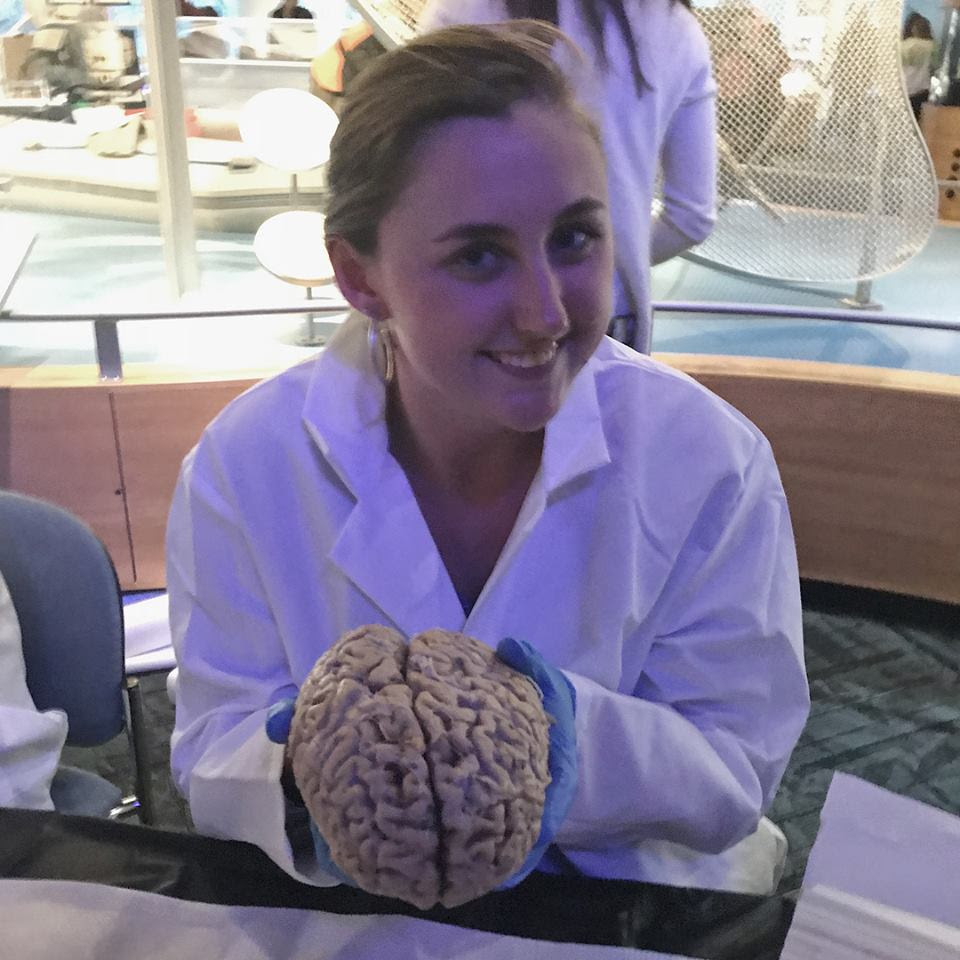 member, Natalie Truby, North Carolina, is volunteering her time teaching the human brain at North Carolina Museum of Natural Sciences. Natalie studies microbiology at NC State University where she is a full time student. Natalie was diagnosed with the epidermoid brain tumor in her teens, and had surgery for the first time June, 2017, at Duke University Medical Center.
member, Natalie Truby, North Carolina, is volunteering her time teaching the human brain at North Carolina Museum of Natural Sciences. Natalie studies microbiology at NC State University where she is a full time student. Natalie was diagnosed with the epidermoid brain tumor in her teens, and had surgery for the first time June, 2017, at Duke University Medical Center.
February 21, 2018
American Brain Tumor Association (ABTA), one of our Partners is having an online conference! ” Computerized Cognitive Training: Brain Games and Brain Training – Feb 21, 2018″ will begin in 1 Day on: Wed, Feb 21, 2018 1:00 PM – 2:00 PM CST Here is the link at the conference time:
https://applauncher.gotowebinar.com/#notStarted/43672989877058051/en_US
JaNiyah’s Journey
JaNiyah received a diagnosis of an epidermoid brain tumor in the skull base location when she was only two years old. Now, at age ten, she has had surgery four times with many months spent in hospitals and rehabilitation.
Recently this year, in May 2017, JaNiayh was found unresponsive and was airlifted to the hospital. Now back at home after receiving hospital care for two months, she is better. Living with a brain tumor daily after surgery can be disabling for the patient. There is always the fear that yearly MRIs will show regrowth, thus another surgery. For a few, regrowth happens within a year or two if one tiny cell is missed/left at surgical location, then the tumor regrows. Many of our members have had over six or seven brain surgeries with one member having over twelve.
When JaNiyah’s mother joined the Epidermoid Brain Tumor Society, she asked, “do members have an epidermoid brain tumor?” After reading posts from others, she soon gained much needed information and support. She had been told by JaNiyah’s doctors of the rareness of the eidermoid brain tumor and thought that her daughter was the only one in the world. She quickly found other parents whose children suffered with the diagnosis of the epidermoid along with the adult members. She no longer feels alone.
JaNiyah’s fourth surgery unfortunately has left her in a wheelchair. When asked about JaNiyah’s favorite things to do, her mother says she likes hanging out with her. Also playing outside with her big brother and looking at movies. The last four years of life, JaNiyah has been subjected to many treatments as the neurosurgeon tries to treat her epidermoid brain tumor. They can’t seem to make it go away or stop growth.
The epidermoid brain tumor is rare and benign. It forms very early in pregnancy, and its effects last a lifetime. Medical literature only has articles of surgery and a few articles that list it as a benign cyst or tumor. Thus, the existence of the Epidermoid Brain Tumor Society (EBTS), formed officially as a 501©3 in 2012 with the goal to facilitate awareness, support and research. EBTS has grown and now has over 760 international members. We want and need research to improve patient outcomes and quality of life. After surgery, there are many members with disabilities who never go back to their old life after surgery. The skull base is very complicated with 12 cranial nerves that control all functions of the body from swallowing, walking, talking, and breathing.
The mission of EBTS is awareness, support and research. EBTS has joined with Amazon Smile to make this happen for our members and their families! It is an ideal situation. We appreciate the donations from Amazon Smile to our organization, as we encourage members to use http://smile.amazon.com/ch/46-2856696 each time they shop! We are an all-volunteer organization, and all donations are being collected to fund our own research into the epidermoid brain tumor. Amazon Smile works for EBTS. Thank you, Amazon Smile!
July 2017
Some fun for summer! MRI Music!
May 2017
May is Brain Tumor Awareness month! We will be sharing different items with you all month. We encourage you this month only, if you have been helped in some way by our organization, that you may donate towards our goal, to bring awareness, education, and support to members, and fund raise towards research of this terrible but ‘benign’ tumor! Donations of ANY amount are welcome. Check our donate page on our website, mail a check for all of your donation to come to us, or use Paypal for your convenience!
www.epidermoidbraintumorsociety.org/donate Remember, we also have partnered with smile.amazon.com and Bravelets.com for all of those who shop online! We thank all of our loyal members for your support, and continued support of other members!
May 2017
Our Partner American Brain Tumor Society is having an online workshop on May 16th titled ‘Returning to work after a Brain Tumor Diagnosis’. You may sign up here: https://attendee.gotowebinar.com/register/3346731257952342019
April 2017
Fundraiser by our own Matt Cardoza!
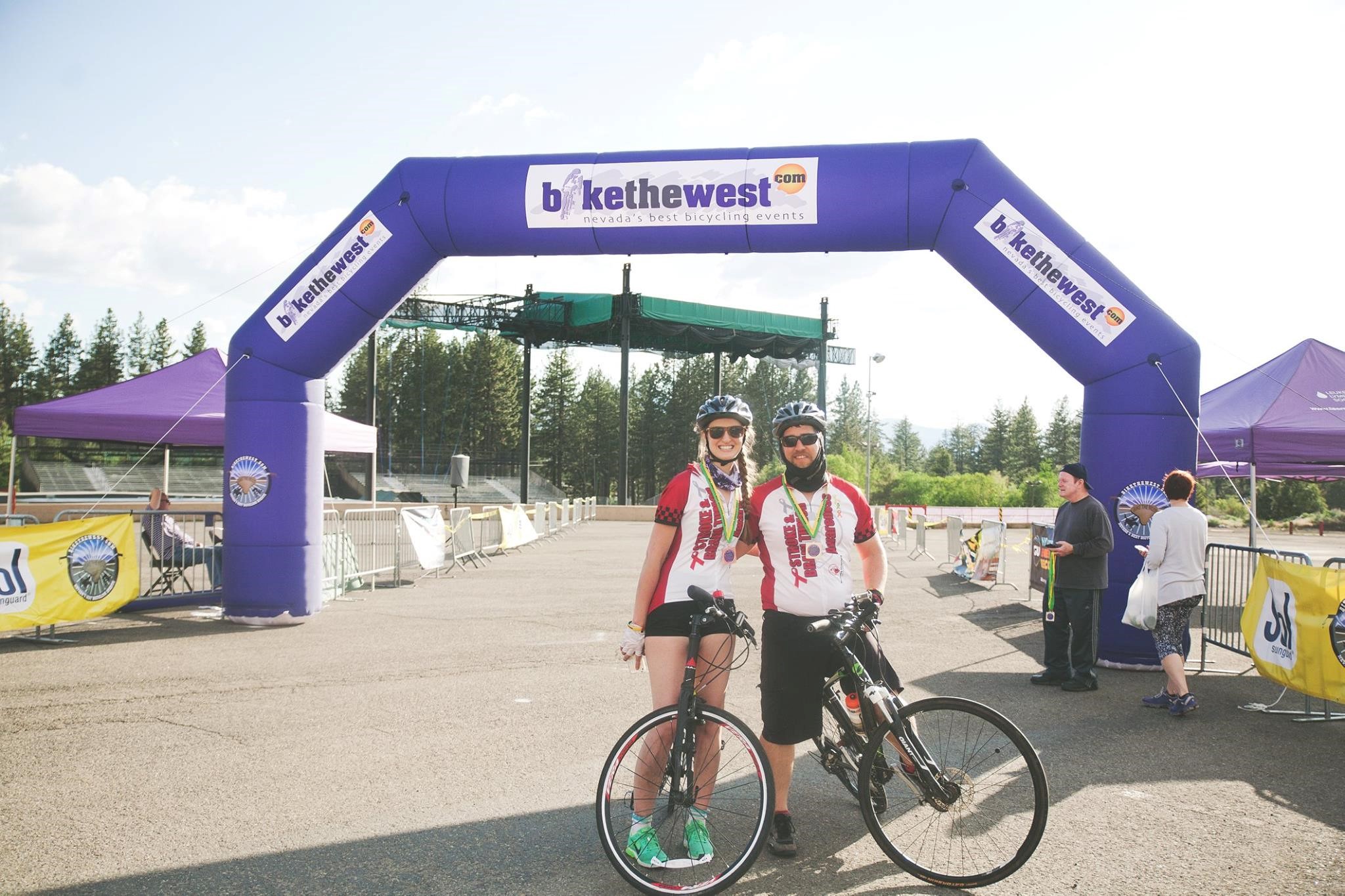
On June 4th, EBTS member Matt Cordoza, Sacramento, Ca. will be riding his bike again around Lake Tahoe along with his wife, Kendra Larsen Cordoza, and friends in support of Shriners Hospitals for Children and the Epidermoid Brain Tumor Society.
https://www.gofundme.com/ShrinersNorCal1 In the past years, Matt has been very successful in his fundraising for charities. This year, 2017, Matt is designating that 75% of donation will go to Shriners Hospital for Children and 25% will go to the Epidermoid Brain Tumor Society. EBTS is excited about Matt’s effort and pleased to be a recipient of his 2017 fundraising. In preparation Matt is gearing up by creating a webpage for bike riders to join him in his charity ride. The name of the ride is America’s Most Beautiful Bike Ride (AMBBR). Matt will use this webpage for tracking, communicating, and recruiting bike riders. https://www.strava.com/…/ambbr-shriners-and-ebts-stroke-and… EBTS is not creating or directly involved with Matts Ride, however the Board has approved of the posting of Matts Go Fund Me Fundraiser.
Matt was diagnosed in 2003 at the age of 24 and had his first epidermoid surgery the same year. His second surgery was in 2008. At this surgery the surgeon accidentally cut the AICA artery causing a severe stroke. Matt with therapy had to relearn how to swallow, walk, and talk . Before being diagnosed with the epidermoid, he had completed a bike ride around Lake Tahoe. With a passion for helping and giving to others, Matt decided that he would try bike riding again. With determination and many hurdles he finally worked his way up to riding his bike, and then he began to ride for a cause. Believing that a cause makes one stronger he kept pushing through years for his cause. He had two failed attempts in 2012 and 2013, but completed the full 100 miles in 2014. He has not stopped and in these years has raised funding for his favorite charities and has spread awareness. This year he has picked Shriners Hospital for Children and Epidermoid Brain Tumor Society. In last year’s post for his charities, Matt writes “Never give up hope, there was a time when I was not sure I would walk again, last year I rode my bike over 4,000 miles.” Wishing you the best on this years ride Matt!
March 2017
EBTS Board Meeting
New Officers were elected for the EBTS Board for 2017. They are:
Denise Isenhour, Chairman
Linda Frever RN, BSN President/Secretary
Brian Towne, Treasurer
Other board members are:
Kelli Luff
Lee Ann Provenzano
Jennifer Moreau
Sonya P.
Tina T.
February 2017
Today is Rare Disease Day, February 23, 2017!
Our Partner Global Genes Foundation Alliance has a member who made a slide show for children, to explain about Rare Diseases! Take a look and feel free to share!
https://docs.google.com/presentation/d/1PMRgrT0VcaEnCFVyCQTJsp09OdHnkAzmPeH-c1_9tac/edit?ts=58b108b1#slide=id.g1c393870fd_0_25
EBTS Releases Volume III Newsletter February 2017
Dear Members: The Epidermoid Brain Tumor Society (EBTS) is a nonprofit medical support organization advocating awareness and research. We offer information, inspiration, support and hope for those affected by the epidermoid brain tumor. EBTS also provides factual information first hand to the many medical professionals that have an interest in the epidermoid brain tumor. In this Volume 3 of the EBTS Newsletter, we would like to share with you what has been happening in the EBTS organization since the last newsletter. We have experienced growth and have many more diagnosed epidermoid patients joining us for information. Welcome to our new members this year, and any others we may not have given a proper hello. We are glad to have you join us.
~ EBTS Newsletter Team
EBTS encourages members to have several surgical consults before agreeing to surgery. Best surgical outcomes are generally from large medical centers with Skull Base surgical departments. Even then, the surgical experience and results of a surgeon is most important in determining who will be your surgeon! Many members over the years have traveled out of state to have the surgery choice of a skilled and experienced skull base neurosurgeon. Members often share on Facebook their surgeons’ names. We may contact members privately for updates on their recovery, and allow members to respond to inquiries about their surgeons.
EBTS continues to grow with members from all over the world and now in 2017, EBTS has grown from a small core membership group from an old list serve (email) organization to an organized 501c3 charity. Our Webpage and Facebook support group has over 650 worldwide members. Many members are newly diagnosed and are finding EBTS post-surgical and write of their deficits, complications of surgery, recuperation along with all patient members writing of their fear of annual MRI’s which may tell of re-currency. EBTS members of all ages, come from all walks of life and live all over the world. EBTS members have interesting careers from business, engineering, education, medicine, law and artistic endeavors with talented authors, photographers, and artists. Some must place careers on hold post-surgical because of long recuperation and deficits. Some may have to adapt to a new normal and change their careers. Their life has been interrupted by this rare brain tumor, but they never think of giving up. Members only think about “keep on, keeping on” or as we say “KOKO”.
Dr. Chris Chiou, Michigan, recently finished his medical residency in Family Practice in March, 2016 after placing it on hold at the beginning of his 3rd year. His life was interrupted by the epidermoid brain tumor in March, 2013. Dr. Chiou went from fully functional to disabled overnight from post-surgical deficits. With determination and courage and over 20 months, he reentered his medical residency and graduated in March, 2016. Dr. Chiou’s personal story is found in his column ‘House Call’, on our EBTS website: https://epidermoidbraintumorsociety.org/house-call/
EBTS had almost 40 members have surgery in 2016 by early December! Two members were married, but not to each other! Five moid families added a baby to their family, and four grandmothers reported births of their grandchildren! We reported several meet ups, many accomplishments with school or work, and two members who ran together in a half marathon!
On behalf of the board and EBTS members, It is with much appreciation that we write to thank Fay Powell for her many years of service to the EBTS. Fay has decided to retire from the board of administrators effective this past January 1, 2017. Since 1999, she has provided support to hundreds of EBTS members from offering advice, providing information or even visiting members in the hospital pre or post-surgery. Fay has been a stepping stone into the advancement of where the group is to this day. From a simple email server to a 501c3 registered charity, Fay has been there through it all. She has worked tirelessly serving on the Board and advising the Website, Newsletter, Research, Development and Fundraising committees and as an admin to the Facebook group. We will surely miss Fay’s “Mother Hen” presence she has effortlessly provided every day. Fay, we love you and thank you from the bottom of our hearts for all that you are and all that you have done for each and every one of us. Enjoy your retirement and please stay in touch. Yours Truly, EBTS Board & Members
January 31, 2017 EBTS had their Annual Board Meeting. Your officers for 2017 are Chairman: Denise Isenhour, President: Linda Frevert, Treasurer: Brian Towne, Secretary: Linda Frevert.
Remembrances
On November 19, 2015, EBTS received news from Sharon Black Schatz, Iowa, the Schatz Family, Iowa, of the death of their beloved 43- year-old son, Jamie Schatz, Wisconsin, from complications of the epidermoid brain tumor surgery. Jamie had emergency surgery February 7, 2015, at St. Francis in Milwaukee, and was moved to King, VA, near Wacupa, Wisconsin. Since surgery in February 2015, Jamie had 8 surgeries and only back home but a few days. Shunt malfunction was a constant problem along with several other medical complications of blood clots in lung and leg and a mild heart attack. Jamie, an Iraq veteran, was married and leaves a wife and two small children. Our heartfelt sympathies go out to parents, Al and Sharon Schatz, Iowa, and sister, Lori Schatz Miller, Iowa, all members of EBTS.
EBTS sends condolences to member Katie Enever, UK, and her family. Katie’s mother, Margaret Enever, passed away on February 7, 2016, in the UK. Margaret, living in south of France at the time of her 2013 diagnosis returned to her native UK for surgery. Katie joined EBTS as her mother did, to gain information from us, and moved from Thailand where she was working to the UK to be with her mother. Margaret was asymptomatic and only had problems with balance and had survived a few falls. She was 72 years of age. Katie mentioned in her first posts about her mother showing signs of short term memory loss and wanted to know if this could be age related or an epidermoid symptom. Later, the consultant, prior to surgery, Sept. 2015, categorically told the family that Margaret did not have dementia, only symptoms related to the epidermoid brain tumor. After surgery, a shunt was inserted to control hydrocephalus. This did not work and the family was then informed that Margaret had vascular dementia. Needing full time care, the family moved Margaret to a care home until her death.
EBTS was very saddened to read the post of UK’s Andrew Mills informing of the May 31, 2016, passing of his dear wife, Christine Mills, UK, who had suffered the past few years with an epidermoid brain tumor. Christine (Chrissie) was diagnosed with an epidermoid brain tumor many years ago and had many surgeries in her lifetime. We share your sorrow, Andrew. Our hearts are saddened by your loss and our thoughts and prayers are with you.
We mourned the deaths of these members in 2015 and 2016.
Useful Research and Information
Epidermoid Brain Tumor Society mission as a medical support group is to share information about the epidermoid brain tumor and to spread awareness. http://rarediseases.org/organizations/epidermoid-braintumor-society/
Renowned skull based neurosurgeon, Dr. Takanori Fukushima, is requesting his epidermoid surgical patients who are members of EBTS to contact him. Dr. Fukushima is currently in the process of researching the epidermoid brain tumor and has requested that his patients contact his office about their condition or send past year MRI’s to his office. Local patients that are EBTS members need to come in and see Dr. Fukushima. This will help greatly to get results on paper quickly. When completed, Dr. Fukushima will share the research with EBTS organization. Contact information: http://www.carolinaneuroscience.com/ or http://takanorifukushima.com/
Questions Asked by Members/Information Shared
More times than one can count, the question about recurrence of the epidermoid brain tumor is asked, and also can the epidermoid brain tumor have radiotherapy or be radiated. EBTS shares this link in response: Tumor recurrence rate of 9%. Radiotherapy for recurrent epidermoids: http://www.ncbi.nlm.nih.gov/pubmed/23400752
Alcohol use with a brain injury: http://www.brainline.org/content/2012/06/alcohol-use-after-traumatic-brain-injury_pageall.html
Has Management of Epidermoid Tumors Improved? http://europepmc.org/articles/PMC2435477
How Important is it to Find a Skull Based Surgeon? https://www.mdanderson.org/transcripts/tender-treatment-for-rare-skull-base-tumors.htm
Psychiatric Issues with Traumatic Brain Injury http://www.slideshare.net/lillygodiva/psychiatric-issues-in-traumatic-brain-injury
Tumor Re-Occurrence Rates http://www.ncbi.nlm.nih.gov/pubmed/25558422
Prepare for Surgery and Recovery http://www.mayfieldclinic.com/PE-Craniotomy.htm
Hydrocephalus and Shunts http://www.hydroassoc.org/shunt-systems/
Giant Epidermoids, Is Total Removal Feasible? https://www.ncbi.nlm.nih.gov/pubmed/25594324
Disability Evaluation https://www.ssa.gov/disability/professionals/bluebook/11.00-Neurological-Adult.htm#11_05
Thank you to member Jerry Parker, Illinois, for sharing this insightful article, “Making the Cut: Why Choosing the Right Surgeon Matters More Than You Know.” It is about the importance of picking the right surgeon and states, “So many posts on our forum discusses this issue and the article reinforces it with data.” https://www.propublica.org/article/surgery-riskspatient-safety-surgeonmatters
EBTS knows that any support organization is only as strong as its members and we appreciate the caring support that membership does in regard to sharing your own story or experiences as you journey with the epidermoid brain tumor.
Please join us in funding research and awareness of the epidermoid tumor! https://epidermoidbraintumorsociety.org/donate/
Contact us by email at: [email protected]
Wishing you the Best for 2017!
~EBTS Newsletter Team
February 2017
We are Partners with NORD and Global Genes Allliance. Board member of GGA and psychologist Kathleen Bogart at Oregon State University has a study that some in our organization might be interested in participating. “The study focuses on quality of life among people with a variety of rare diseases. The outcome of this project will be to provide information to rare disease organizations and healthcare professionals about how best to support quality of life needs. Make this the largest study on quality of life with a #raredisorder. Please share!” Here is the link for more information.
https://oregonstate.qualtrics.com/jfe/form/SV_7VEgG8kwTizenAN
May 2016
EBTS dedicates our 3rd Annual
May Brain Tumor Awareness Month
to Dr. Chris Chiou, Michigan.
Dr. Chris Chiou recently finished his medical  residency in Family Practice in March, 2016, after placing it on hold at the beginning of his 3rd year. His life was interrupted by the epidermoid brain tumor. In March, 2013, Dr. Chiou was diagnosed with a 4.5 cm brain mass in the posterior fossa. The next week, the mass was removed in a 16 hour surgery. The mass was identified as an epidermoid brain tumor. Since surgery, Dr. Chiou went from fully functional to disabled overnight from post-surgical deficits. These past years, Dr. Chiou has been challenged with deficits from the epidermoid surgery, yet he never gave up. With determination and courage, he reentered his medical residency and graduated in March, 2016.
residency in Family Practice in March, 2016, after placing it on hold at the beginning of his 3rd year. His life was interrupted by the epidermoid brain tumor. In March, 2013, Dr. Chiou was diagnosed with a 4.5 cm brain mass in the posterior fossa. The next week, the mass was removed in a 16 hour surgery. The mass was identified as an epidermoid brain tumor. Since surgery, Dr. Chiou went from fully functional to disabled overnight from post-surgical deficits. These past years, Dr. Chiou has been challenged with deficits from the epidermoid surgery, yet he never gave up. With determination and courage, he reentered his medical residency and graduated in March, 2016.
Writing in his recent column, “House Call”, he wrote of re-entrance back to his life being rocky and continues to be an ongoing journey, but one that was necessary. It took 20 months before Dr. Chiou was back in his residency. Dr. Chiou’s personal story is found in his introduction on our “House Call” Blog page:
https://epidermoidbraintumorsociety.org/2015/02/introduction-dr-chris-chiou/
In a House Call article written especially for our EBTS membership, Dr. Chiou, in expressing thoughts of what or who is to blame for the epidermoid brain tumor, relates to members that his condition is NO-ONE’S fault. “I just happened to win the lottery for getting a congenital brain mass – because the mass and its location are so rare, I have had difficulty coming up with studies or articles that cite the chance of having this type of mass (with the ensuing symptoms), but according to my calculations, less than one in a million people will have this mass in their posterior fossa with subsequent Posterior Fossa Syndrome. I can either search for someone or something to blame this on, or just cough it up to luck (good or bad). After much thought, I’ve realized it really doesn’t matter whose fault it is. After a tragedy, our thoughts should not be, Who’s to blame? It ought to be, How can this be prevented in the future? How can others avoid the same mishap? Instead of looking for someone or something to blame, would it not be more productive to find the source of the problem?”
Rapid Regrowth After Surgery- A Case Study
A 30 year old woman had surgery for a large epidermoid, and had regrowth within a year. After a second surgery she had regrowth within 6 months. The surgeon took a specimen and had it grown in a lab for a ‘prolonged’ time, and it showed a low grade Staphylococcus infection. She was treated for the infection and had no further issues. See the study here: http://www.ncbi.nlm.nih.gov/pmc/articles/PMC1502036/
NEWSLETTER
Fall/Winter 2015 – Volume II
Dear Members and Friends:
The Epidermoid Brain Tumor Society (EBTS) issues our annual newsletter to members and friends in order to strengthen and spread awareness about the epidermoid brain tumor. With our recent questionnaire, EBTS discovered many of our 400 members were not active posters or readers and did not see the research survey pinned to Facebook support. Therefore, in order that EBTS news and activities of EBTS will go out to everyone; this is the effort of administrators to reach those with an email address registered with EBTS from Facebook: https://www.facebook.com/groups/epidermoidbraintumorsociety/
and webpage membership: https://epidermoidbraintumorsociety.org/
EBTS, a non-profit, is a medical support organization advocating awareness and research. We offer information, inspiration, support and hope for those affected by the epidermoid brain tumor. EBTS also provides factual information first hand to the many medical professionals that have an interest in the epidermoid brain tumor.
We hope everyone had a great spring/summer. In Volume 2 of the EBTS Newsletter, we would like to share with you what has been happening in the EBTS organization since the last annual newsletter. We have experienced growth and have many more patients and parents joining us for information. Ages of the newly diagnosed are from two years of age to late sixties. Welcome to our new members this year, and any others we may not have given a proper hello! We are glad to have you join us.
~ EBTS Newsletter Team
The epidermoid, a rare and benign (i.e. non-cancerous) tumor of the brain, is made up of normal skin cells (stratified epithelial lining) on the outside, and fatty acids and (desquamated) keratin on the inside of the tumor or sac. Only the sticky outer layer is alive thus sticking to brain tissues and nerves. These tumors arise from ectodermal (skin) cells entrapped during neural tube closure. The tumor forms from the 3rd to 5th week of fetal development. Rarely, it can be acquired because of injury or surgery. The incidence of intracranial epidermoids is between 0.2% to 1.8% of all brain tumors diagnosed in a year.
Intracranial epidermoid tumors are slow-growing lesions, which may recur after incomplete resection (surgery), but may do so over many years. The epidermoid is difficult, but not impossible to remove from location even though epidermoid tumors encase and surround nerves and arteries rather than displacing them. The treatment of choice is surgery. The other option is watch and wait, if possible. The skull base neurosurgery for removal is challenging and requires a very skilled skull base neurosurgeon with experience to give you the best outcome with the very first surgery.
Please check the EBTS website and Dr. Chris Chiou’s ‘House Call’ for more information about epidermoids and a growing trend of the medical community classifying these benign tumors as cysts.
EBTS would like to inform members that at the time of surgery, if the decision is made to have surgery, that a request to your neurosurgeon to save a tissue sample for future research of the epidermoid would be commendable. The patient will have to give permission to do so. Also the preparation for this sample to be placed for holding in a tumor repository may incur a fee which is very nominal. A Duke researcher’s correspondence with EBTS about research stated: “this is the one of the best things that our Society could do is to start collecting samples of the epidermoid tumor. This would be a large undertaking because the Society would have to decide what information (clinical) could be collected, yet, from a scientist’s perspective; it all starts with having access to well-characterized clinical information and samples on which to perform genetic/genomic analyses.”
Linda’s Tip
How to find a good neurosurgeon?
EBTS patients are very familiar with Linda Frevert RN, BSN, who patiently answers all questions day and night…she is really on call 24/7. Linda joined the early epidermoid organization when diagnosed in 2001. She is a wait & watch patient with years of experience with research in epidermoid brain tumors and complications of surgery for the epidermoid. The organization would not be what it is today without Linda and her dedication to the Epidermoid Brain Tumor Society.
How do we find a skull base neurosurgeon to begin our search if and when we need surgery? Look up the doctor online and Yahoo search is useful to find a neurosurgeon’s professional page. Where did they go to school? If school is a recognized name, then they had to have “smarts” to even be there. Then look at their specialties and areas of interest. If your tumor is deep in the skull base, below your eyes, then you need a skull base neurosurgeon. Look for skull based tumors, skull lesions, and it should be closer to the top of the list. For example spine and neck surgeries should not be listed above the skull based area of interest! You do not want a spine surgeon! Although the ankle is connected to the knee through the leg, you would not go see a foot doctor to replace your knee! It is all specialized now. Same within the brain. “Practice makes Perfect” is my motto. Just like you and your job, the more you do it, the better you do it! Here is one example of a skull base surgeon that I consulted with in 2001. Look for the words skull base. That’s what you should see on any surgeon’s informational webpage you consult with! http://www.mayoclinic.org/biographies/link-michael-j-m-d/bio-20053693
Dr. Chris Chiou’s House Call
 The Epidermoid Brain Tumor Society welcomes Dr. Chris Chiou to its membership. In March, 2013, Dr. Chiou was diagnosed with a 4.5 cm brain mass in the posterior fossa. The next week, the mass was removed in a 16 hour surgery. The mass was identified as an epidermoid brain tumor. Since surgery, Dr. Chiou went from fully functional to disabled overnight from post-surgical deficits. In May, 2014, he decided that his story needed to be told and began the blog http://www.handicappeddoctor.com/ Reprinting articles from his own blog, and writing new ones especially geared to the epidermoid patient, Dr. Chiou shares his particular insight with his own journey, both as a doctor and as a patient. https://epidermoidbraintumorsociety.org/house-call/
The Epidermoid Brain Tumor Society welcomes Dr. Chris Chiou to its membership. In March, 2013, Dr. Chiou was diagnosed with a 4.5 cm brain mass in the posterior fossa. The next week, the mass was removed in a 16 hour surgery. The mass was identified as an epidermoid brain tumor. Since surgery, Dr. Chiou went from fully functional to disabled overnight from post-surgical deficits. In May, 2014, he decided that his story needed to be told and began the blog http://www.handicappeddoctor.com/ Reprinting articles from his own blog, and writing new ones especially geared to the epidermoid patient, Dr. Chiou shares his particular insight with his own journey, both as a doctor and as a patient. https://epidermoidbraintumorsociety.org/house-call/
Dr. Chris Chiou’s article in House Call’s May, 2015, gave an insightful view with an interview of his own skull base neurosurgeon, Dr. Cormac Maher, University of Michigan Health System. http://medicine.umich.edu/dept/neurosurgery/cormacmaher-md
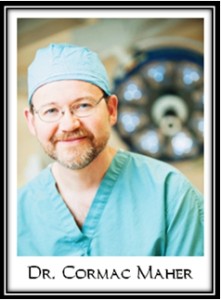 Dr. Chiou writes his lead-in: “Dr. Cormac Maher specializes in skull base tumors, often the location for Epidermoid Tumors. In fact, in full disclosure, he is the Neurosurgeon who operated on me. To be exact he is a Pediatric Neurosurgeon, but when I saw one of the head adult Neurosurgeons at the University of Michigan, he told me (regarding my tumor) “Chris, I am going to have one of my colleagues, Dr. Maher, a Pediatric Neurosurgeon, see you. To be honest, he is much more experienced than I in this location. If it were my son, I’d want him to see Dr. Maher.” “Neurosurgery is an amazing field; one that not only requires exact precision, but also one that demands an incredible amount of time and devotion. Knowing this, I was very grateful that Dr. Maher would take time out of his busy schedule to answer my questions.” EBTS is also grateful that Dr. Masher graciously shared his thoughts on skull base neurosurgery. https://epidermoidbraintumorsociety.org/2015/05/interview-with-a-neurosurgeon/
Dr. Chiou writes his lead-in: “Dr. Cormac Maher specializes in skull base tumors, often the location for Epidermoid Tumors. In fact, in full disclosure, he is the Neurosurgeon who operated on me. To be exact he is a Pediatric Neurosurgeon, but when I saw one of the head adult Neurosurgeons at the University of Michigan, he told me (regarding my tumor) “Chris, I am going to have one of my colleagues, Dr. Maher, a Pediatric Neurosurgeon, see you. To be honest, he is much more experienced than I in this location. If it were my son, I’d want him to see Dr. Maher.” “Neurosurgery is an amazing field; one that not only requires exact precision, but also one that demands an incredible amount of time and devotion. Knowing this, I was very grateful that Dr. Maher would take time out of his busy schedule to answer my questions.” EBTS is also grateful that Dr. Masher graciously shared his thoughts on skull base neurosurgery. https://epidermoidbraintumorsociety.org/2015/05/interview-with-a-neurosurgeon/
Epidermoid Brain Tumor Society is registered in the NORD Patient Organizations Database
http://rarediseases.org/organizations/epidermoid-brain-tumor-society/
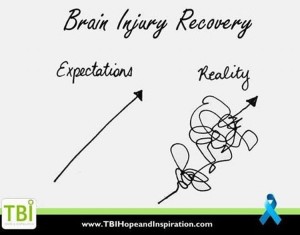 Recently, a new member posted on EBTS Facebook with this illustration and a question to members. “My husband had most of an epidermoid brain tumor removed on December 16, 2013. We were told, prior to the surgery, that his recovery should just take a few months and he would be back to “normal”. His voice, swallowing abilities, memory, cognitive abilities and entire right side of his body are still not functioning correctly, but all of his Dr.’s just continue to say it will take time. This has been very frustrating. Is there something we should be doing to help his recovery?” Immediately, members posted and rallied around this new member and her post-surgical husband who has deficits from epidermoid surgery.
Recently, a new member posted on EBTS Facebook with this illustration and a question to members. “My husband had most of an epidermoid brain tumor removed on December 16, 2013. We were told, prior to the surgery, that his recovery should just take a few months and he would be back to “normal”. His voice, swallowing abilities, memory, cognitive abilities and entire right side of his body are still not functioning correctly, but all of his Dr.’s just continue to say it will take time. This has been very frustrating. Is there something we should be doing to help his recovery?” Immediately, members posted and rallied around this new member and her post-surgical husband who has deficits from epidermoid surgery.
Our EBTS medical administrators were quick to respond with good feedback:
Kate Hughes Könnecke, Germany: I work in Neuro Rehab. The answer is therapy, therapy, therapy. Occupational, speech, physio, Sports therapy and, if possible, neuropsychological. I am now 12 years post-surgery. I am still doing physio and occupational therapy. Can compensate my deficits so well that people don’t notice. Driving: big subject. We perform obligatory tests and around 50% fail due to cognitive deficits. I did too. Took 2 years of neuropsychological training to be fit to drive – have a visual attention deficit (also known as visual neglect) a disorder of the right parietal lobe. The cerebellum imitates other neurological deficits (*Diachisis). My remaining problems are a hemiparesis, dystonia, epilepsy, vestibularis paroxysms, an acquired arachnoidal cyst & mild cognitive deficits.
With a lot of training I drive, work full time etc., but it is all done to training and doing a lot of “homework” e.g. doing physio also by yourself at home and not just during sessions. *Diaschisis (from Greek διάσχισις meaning “shocked throughout”) is a sudden loss (or change) of function in a portion of the brain connected to a distant, but damaged, brain area. The site of the originally damaged area and of the diaschisis are connected to each other by neurons.
Linda Patterson Frevert, Kansas, US: I agree, THERAPY! Over a couple of dozen members had surgery last year, and almost half have some lingering problems, or had severe early complications. It is life changing. See our website Resources:
https://epidermoidbraintumorsociety.org/resources/, and also http://www.tbiguide.com/
EBTS “Shout Outs!”
Look who is hanging out together…

Diane Good Y’all posted August 20, 2015 , “ I got to meet Jay Holmes and Celeste Conrad today. So lucky!”

Yvette Ritmeijer attends Theater Festival Boulevard Den Bosch in August, 2015 with fellow Dutch Moid and dear friend J V.
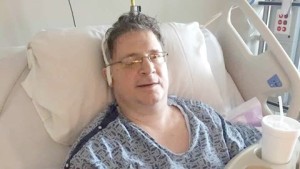 We wish Peter good days recuperating from his 6th.surgery in July, 2015. Peter will have surgery again in October, 2015. Hopefully, may it be his last one. Peter’s sister, J writes, “This is my brother Peter. He had surgery at Duke, Durham with Dr. Fukushima and Dr. Zomorodi. He is now back in Grand Rapids in a rehab facility. He’s doing well, but is suffering from steroid sickness. Peter has Super Tumors. As fast as they debulk them it seems another one appears. Dr. Fukushima will perform Peter’s 7th surgery at the end of October. We take our miracles in small doses.”
We wish Peter good days recuperating from his 6th.surgery in July, 2015. Peter will have surgery again in October, 2015. Hopefully, may it be his last one. Peter’s sister, J writes, “This is my brother Peter. He had surgery at Duke, Durham with Dr. Fukushima and Dr. Zomorodi. He is now back in Grand Rapids in a rehab facility. He’s doing well, but is suffering from steroid sickness. Peter has Super Tumors. As fast as they debulk them it seems another one appears. Dr. Fukushima will perform Peter’s 7th surgery at the end of October. We take our miracles in small doses.”
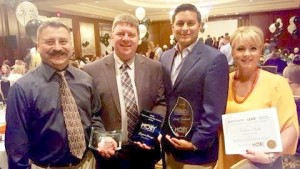 Vincent Thomé, second from left in this photo, recently traveled to Houston for HOBY – Hugh O’Brian Youth Leadership’s Training Institute. In message, he admitted: “It was some of the most rigorous and rewarding training that I’ve had the privilege of participating in as a volunteer. I’m honored to be among a select few leading the 2016 Leadership Seminars as Chair of HOBY New Mexico. Our organization was recognized for OUTSTANDING leadership, 136% growth at our 2015 Seminar, our first-ever Community Leadership in Las Cruces.” Vincent Thomé is an epidermoid brain tumor survivor and his personal story can be found in Stories on the EBTS website.
Vincent Thomé, second from left in this photo, recently traveled to Houston for HOBY – Hugh O’Brian Youth Leadership’s Training Institute. In message, he admitted: “It was some of the most rigorous and rewarding training that I’ve had the privilege of participating in as a volunteer. I’m honored to be among a select few leading the 2016 Leadership Seminars as Chair of HOBY New Mexico. Our organization was recognized for OUTSTANDING leadership, 136% growth at our 2015 Seminar, our first-ever Community Leadership in Las Cruces.” Vincent Thomé is an epidermoid brain tumor survivor and his personal story can be found in Stories on the EBTS website.
 EBTS member, J O, Mass., with team mate on back, participating with family/friend team mates in the challenging MUDDERELLA on September 12, 2015. Mudderella Run is 5-7 miles with 14-16 obstacles. J O had successful second surgery on October 12, 2014 by Dr. Fukushima at Raleigh/Durham Hospital. J O is an epidermoid brain tumor survivor and says, “I am actually in the best shape of my life. I work-out 5 days a week and I starting running 3 months ago as well to prepare”. Mudderella is a charity run for Futures without Violence. This charity accepts charity partners across the globe and if EBTS members would like to participate in an event in 2016, please let EBTS know of your interest. http://mudderella.com/charity-partners/
EBTS member, J O, Mass., with team mate on back, participating with family/friend team mates in the challenging MUDDERELLA on September 12, 2015. Mudderella Run is 5-7 miles with 14-16 obstacles. J O had successful second surgery on October 12, 2014 by Dr. Fukushima at Raleigh/Durham Hospital. J O is an epidermoid brain tumor survivor and says, “I am actually in the best shape of my life. I work-out 5 days a week and I starting running 3 months ago as well to prepare”. Mudderella is a charity run for Futures without Violence. This charity accepts charity partners across the globe and if EBTS members would like to participate in an event in 2016, please let EBTS know of your interest. http://mudderella.com/charity-partners/
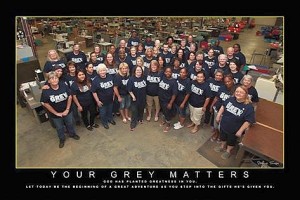 Not at a loss for supporters, J D, Texas, whose son R D had epidermoid brain tumor surgery June 24, 2015, shows support of friends and coworkers.
Not at a loss for supporters, J D, Texas, whose son R D had epidermoid brain tumor surgery June 24, 2015, shows support of friends and coworkers.
Games for the Brain
Play quiz, memory & brain games to train your thinking. http://www.gamesforthebrain.com/
Good News
Miraculous! “To have and to hold, for better or for worse, for richer, for poorer, in sickness and in health, to love and to cherish; from this day forward until…”
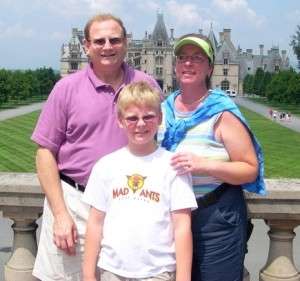 EBTS has updated the Jane and Mike Greener story! Jane had surgery twice in 2015. This story tells much of the couple’s journey living and coping since Jane’s diagnosis and surgery for the epidermoid since diagnosed in 1989, four years after their wedding. Thanks again, Mike and Jane Greener, for sharing your journey with the “Miraculous” story on EBTS webpage. https://epidermoidbraintumorsociety.org/miraculous/
EBTS has updated the Jane and Mike Greener story! Jane had surgery twice in 2015. This story tells much of the couple’s journey living and coping since Jane’s diagnosis and surgery for the epidermoid since diagnosed in 1989, four years after their wedding. Thanks again, Mike and Jane Greener, for sharing your journey with the “Miraculous” story on EBTS webpage. https://epidermoidbraintumorsociety.org/miraculous/
In 2015, Members of EBTS had June weddings! Please meet our newlyweds…
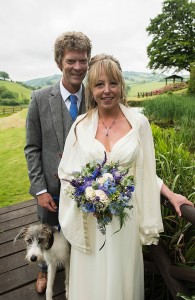 Naomi and Pete Marley, UK, and Hurley
Naomi and Pete Marley, UK, and Hurley
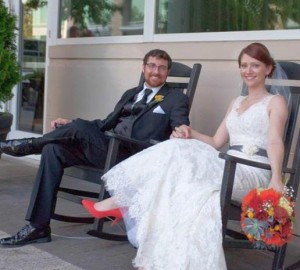 Kari and Chris Cowperthwaite, North Carolina
Kari and Chris Cowperthwaite, North Carolina
2015 Well Wishes to:
Epidermoid Brain Tumor Patients who had epidermoid brain tumor surgery from late 2014 through August, 2015.
J, 6 yr.old daughter of J C, Florida, (4th surgery) 12/2014 Dr. David Pincus, UF Health –ShandsHospital, Gainesville, Fla.
D M S, Pennsylvania 8/14/ 2014 Dr. James Evans, Jefferson University Hospital, Philadelphia, Pa.
M C, California (son of D C Cl) 9/15/2014 Sacramento, Ca.
E K, Delaware (3 surgeries) 9/ 2014, 10/2014, 10/ 2014, Dr. Kevin Judy, Jefferson Neuroscience, Philadelphia, PA
M M M, Philippines (2nd.surgery) l/2015 Philippines Hospital
C M H, Ohio 2015 Dr Recinos, Cleveland Clinic, Cleveland, Ohio
A M, Indiana, (3 surgeries) 2005,1/20/2015 and 1/22/2015 Dr Aaron Cohen-Godahl, IU Health Methodist Hospital, Indianapolis, IN
J G, Indiana, US (4 surgeries) 1/16/15,7/ 1/ 2015 Dr. Fukushima w/ Dr. Zomorodi, Duke/Raleigh Hospital,Raleigh, NC.
Two EBTS members from Iowa shared surgery of their son and brother (Iraq War Veteran) 1/2015
H Z, Turkey 1/28/2015 Turkey Medical Hospital at Armed Forces Base
M F, California 2/9/2015 Lawrence D. Dickerson, MD. , Pacific Brain & Spine Medical Group, Ca.
D M S, Pennsylvania 8/14/ 2014 Dr. James Evans, Jefferson University Hospital, Philadelphia, Pa.
M B, Washington 2/9/2015 Laligam N. Sekhar M.D., UW Medicine, Harborview, Seattle, WA.
C K, Sweden 3/4/2015 Akademiska sjukhuset (Academic Hospital) in Uppsala, SwedenVolume 11, Oct. 1, 2015
M R S, Mass. 3/6/ 2015 Dr. Fukushima and Dr. Zomorodi, Duke/Raleigh Hospital, NC.
H W, Cleveland, Ohio 3/11/2015 M. Vogelbaum, MD., Cleveland Clinic, Cleveland, Ohio, US
H S, UK, (3 surgeries) 3/ 17/2015 Mr. Mathad, Southhampton General, UK
A S, Canada, 4/24/ 2015 Dr. Gentili, Toronto Western/ Toronto General
J/B M’s brother, Fla. 4/24/2015 Dr. John J. Viola, MD, Martin Medical Group, Stuart, Fla.
S T, California, 5/1/2015 University California, San Francisco, CA
S C, Alabama, 5/1/2015 Dr. Zoromodi, Duke University Medical Center, Durham, NC
S L, Indiana (3 surgeries) 5/2015 Dr. Neil Troffkin, Neurosurgical Consultants, Evansville, Indiana
T S’s video of wife’s surgery progress 5/28/2015 in Indonesia by Brig. General Djoko Riyadi, MD Department of NeurosurgeryGatot Subroto Hospital, Jakarta Indonesia Video: https://www.storehouse.co/stories/v13tx-epidermoid-brain-cyst
C C, 6 yr. old daughter of Kirsten Forsberg Cunningham, Mass. 6/3/2015 Drs. Barker and McKennas, Mass. General Hospital
Dr. J C, Singapore (2 surgeries) 6/2015 Wai-Hoe Ng, MD, National Neuroscience Institute, Singapore
M M, Oklahoma, (4th surgery) 6/ 22/ 2015 Michael Sughrue, M.D., OU Medical Center in Oklahoma City, OK
R D, Texas, 6/24/2015 Dr. John Day, UAMS Medical Center, Little Rock, AK
P P, Michigan, US (6 surgeries ) brother of EBTS members J PFronabarger and F P7/9/2015, Dr. Fukushima and Dr. Zomorodi, Duke/Raleigh Hospital, Raleigh, NC
Z K, Scotland 7/9/2015 Mr. Taylor, Southern General Hospital, Glascow, Scotland
M H Lister, Texas, US (3rd. Surgery) 7/27/ 2015 Dr. Jeffrey Cone, Amarillo, TX
T M’s Husband, Michigan 8/12/ 2015, James P. Chandler, MD Northwestern Memorial Hospital, Chicago, Illinois
D K, Camp Lejeune, NC, son of member A K, Virginia, 8/27/2015 Dr. Matthew G. Ewend UNC School of Medicine, Chapel Hill, NC
M M, Florida 8/28/2015, Melvin Field. MD Florida Hospital Neuroscience Institute, Winter Park, FL
M R, Minnesota 9/7/2015, Jamie Van Gompel, MD Mayo Clinic, Rochester, MN
A C L, UK, 9/25/2015 at Salford Royal,UK
P C, Tennessee 9/17/2015 Dr. Kyle Weaver, Vanderbilt, Tenn
Remembering
Joanna Pierotti
January 30, 1957 ~ February 16, 2015
Ron and Joanna Pierotti, Arizona, EBTS members joining around the time of Ron’s first surgery, were very special to long time members. Joanna, a gifted artist and writer, posted members all the ups and downs of life as Ron walked with the epidermoid with her by his side. Their heartbreaking story of Ron’s first surgery and their journey since with the epidermoid brain tumor is posted on EBTS webpage https://epidermoidbraintumorsociety.org/rons-ride-by-ron-pierotti/
On March 14, 2015, A Celebration of Life at Corona del Mar beach, in California, was celebrated by family and friends. It was a perfect day for a lovely lady. Joanna Pierotti will always live in our hearts.
Last Word
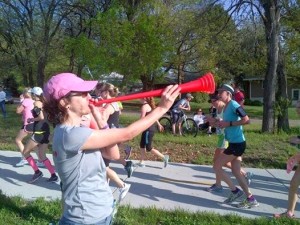 EBTS members do keep on keeping on. Although some members will need a new career, others just need time and hard work to resume their careers!
EBTS members do keep on keeping on. Although some members will need a new career, others just need time and hard work to resume their careers!
Members, P R, US Marine, Texas, and D B W, Nebraska, both with past surgeries and complications, had goals to get back as before and even better. Both posted recently good advice to members to take advantage of cognitive apps, games, word searches, etc. to help with cognitive deficit. They both are, at the moment, back in school. P R is studying for a political science degree at The University of Texas-Pan American (UTPA) and Deb taking classes in social work, seeking a new career. EBTS admires them both because “it ain’t easy” as adults and especially post-surgical for an epidermoid tumor that leaves trauma to cranial nerves.
Dr. Chris Chiou, Michigan, returned back in July, 2015 to complete his last year of residency program in Family Medicine at Sparrow Hospital Lansing, Michigan.
E K, Delaware, has become an EMT, changing her career since her three surgeries and a bout of meningitis last fall, 2014.
J H, New York, on leave now following surgery, is going back for his second year of dental school.
J L, UK, is back part-time with his law career, and he tells us also of his forthcoming marriage next year.
N C M, UK, has newly launched a business, named Sea Cabin, that stemmed out of her own wedding this year. https://www.facebook.com/theseacabin/photos N C M handmade all of her wedding décor. She posts that she is taking knot lessons, a sort of apprenticeship in her spare time with an old sailor who wants to teach her all the historic knots to pass his knowledge on. She is excited about learning these old traditional knots.
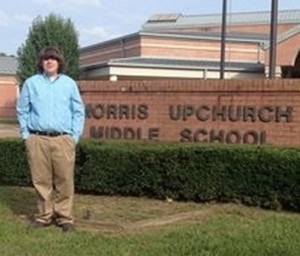
R D,Texas, enters the 9th grade this fall after having surgery in 2015. R D graduated from the 8th grade this year and was 5th in his class. Congratulations R D!
I wish I could figure this out!
I really wish I could!
I do, I do!
EBTS member, Jack Eadon is back from his mission…
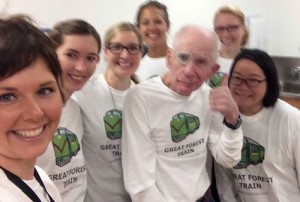 In 1978, an MRI found a large epidermoid tumor in Jack Eadon’s brain. Since that time, he has had four brain surgeries, but improving technology didn’t catch up until the fifth surgery on August 17, 2010, when a top neurosurgeon, Dr. Fukushima, finally totaled the epidermoid brain tumor.
In 1978, an MRI found a large epidermoid tumor in Jack Eadon’s brain. Since that time, he has had four brain surgeries, but improving technology didn’t catch up until the fifth surgery on August 17, 2010, when a top neurosurgeon, Dr. Fukushima, finally totaled the epidermoid brain tumor.
Because of resulting trauma to cranial nerves in the brain stem, in particular these six neurological controlling nerves, that provide the innervation for both swallowing and speech, Jack has not eaten normally in over five years. His intake of nourishment has only been liquid food through a G-Tube.
- CN. V The Trigeminal Nerve
- CN. VII The Facial Nerve
- CN. IX The Glossopharygeal Nerve
- CN. X The Vagus Nerve
- CN. XI The Spinal Accessory Nerve
- CN. XII The Hypoglossal Nerve
Never one to give up, Jack has taken therapy since 2010 to be able to swallow again. His latest therapy was a trip to New Zealand to have dysphagia evaluation and treatment by a highly recommended team at Eats Clinic headed by Dr. Maggie-Lee Huckabee. Jack, a prolific author who writes a good story, sent photos and reports back to EBTS daily of his hard work with the Eats Clinic Team. Tests seemed to be going well, but on Day 8, the morning session was stopped because the upper esophageal sphincter would not relax.
Jack was advised that unless this esophageal sphincter relaxed, there was nothing that could be done by Eats Clinic to make him swallow. Plans for staying longer at Eats Clinic were halted. Jack commented that he felt the trip was useful, and that he did manage to get feedback gaining information from tests. There has been progress. Five years ago, he couldn’t walk, talk, or swallow. Now he can walk, sorta talk (his own words), but haven’t yet swallowed, though he think he’s getting close. He never gives up! In fact, Jack’s going to make it! For more about Jack’s life, go to link: http://blogcritics.org/%20interview-jack-eadon-author%20of-got-to-make-it/
We are partners with Amazon Smile. So, if you shop Amazon, go to https://smile.amazon.com/ look for our organization and shop. Do this each time you shop Amazon and it adds up! Look for Jack’s early book, “You Got to Make It”, sold at Amazon.
A huge “THANK YOU” to J L, UK, who posted a thank you to EBTS that made the administrators’ day. J L speaks from his heart and gives input that just maybe, EBTS’s mission is being accomplished. J L posted on EBTS Facebook on May 25, 2015, the nicest comment. “Can I just say that I think you are a fantastic charity. I live in England and have an epidermoid brain tumour. I wish there was a similar organization in England who specializes in the epidermoid, as I do feel quite isolated. I have learned more about my condition through yourselves, rather than any organization over here. Thank you.”
EBTS member, J L’s, UK, surgery was on 2 September 2010, removing 75% of his tumour. J L is now back at his law practice part time, although he remains tired and forgetful. Every day he tells us that he attempts to complete sudokus and crosswords to keep the mind active. He sets little goals and ticks them off when he reaches them. He has volunteered and raised money for charity. He has made new friends. Next October, he ticks off his (second) biggest achievement . . . he is engaged and will be getting married. Well done, J L!
The year of 2015, EBTS dedicates our 2nd Annual May Brain Tumor Awareness Month
to the children in our group who have challenges with the epidermoid. It has changed their young lives. Their lives going forward are not as bright due to this challenging epidermoid brain tumor. Please help us as we search for answers! There is a great need for research when you read stories like the one below.
At two years of age, JaNiyah’s mother noticed that JaNiyah had weakness on her right side. MRI diagnosis showed an epidermoid in the location of the skull base. Her first surgery for debulking treatment (removing some of the contents of the tumor, not removing the tumor) was June, 2011. The epidermoid sac soon filled back up again resulting in a second debulking surgery in January, 2012. She went a whole year without being in the hospital after this. But because of surgery scar tissue, excess cerebrospinal fluid (CSF) had collected and JaNiyah had to be shunted to remove fluid and improve circulation of CSF. The ventriculoperitoneal (VP) shunt failed, and the doctors’ only intervention was a third debulking surgery in August, 2013. She was placed back in hospital for check in May, 2014, to see if the CSF would circulate correctly with a tube directly placed into tumor to drain the tumor. The thickness of the CSF and contents of the tumor closed the tube. Her neurosurgeon decided against debulking for the 4th time because lack of previous success. JaNiyah’s mother was told that the surgeon would have to go in manually to remove contents. JaNiyah had a traditional craniotomy surgery in December, 2014.
JaNiyah’s fourth surgery unfortunately has left her in a wheelchair. Hopefully by next year, she will make progress and make her wish come true to be a cheerleader for peewee basketball. She likes to sing and dance, so she would be a natural cheerleader. When asked about JaNiyah’s favorite things to do, her mother says she likes hanging out with her, playing outside with her big brother JaNiyah and big brother, Tim, waiting for the school bus in 2014 and looking at movies. And she loves her little cousins and loves being their babysitter when they are around. All in all, JaNiyah’s mother says her “best friend” is full of joy all the time. JaNiyah received a gait walker trainer recently to help her to walk again. She is thrilled her mother says, and JaNiyah is hanging in there from her last surgery with a great positive attitude. Her mother speaks of her as “OK” and a regular six year old girl looking forward to school this fall.
The last four years of life, JaNiyah has been subjected to many treatments as the neurosurgeon and staff at UF Health Shands Hospital, Gainesville, Florida, try to treat her epidermoid brain tumor. They can’t seem to make it go away or stop growth. Research for this brain tumor is needed so that JaNiyah, or any child or adult, does not have to go through life with the challenges of the epidermoid brain tumor diagnosis and treatment. https://epidermoidbraintumorsociety.org/our-stories/janiyahs-journey/
EBTS knows that any support organization is only as strong as its members and we appreciate the caring support that membership does in regard to sharing your own story or experiences as you journey with the epidermoid brain tumor.
EBTS is making epidermoid brain research a reality
Please join us in funding research and awareness of the epidermoid tumor.
https://epidermoidbraintumorsociety.org/donate/
Wishing you a good Fall/Winter, 2015
And a Happy & Healthy New Year!
July 2015
AMAZON SMILE
We now have an association with the charitable arm of the Amazon shopping website. When you shop, one half of 1 percent of your purchase can go to Epidermoid Brain Tumor Society! Simply go to www.smile.amazon.com then look for our organization Epidermoid Brain Tumor Society, click select, then shop to your hearts content, and automatically one half of 1 percent of your purchase will be given to our organization. Each time you shop make sure you go to www.smile.amazon.com. We thank you for your support!
May 2015
End of May Update
“The people most highly motivated to support or to even initiate investigations of a rare condition are those personally affected and their close relatives,”
Truer words have never been spoken as these above. Epidermoid Brain Tumor Society is at a cross roads and needs your help to take the next step. Last year for May Brain Tumor Awareness month, EBTS was the recipient of a $500 grant from Fidelity Bank for research and also the recipient of donations from Fidelity coworkers of a EBTS volunteer who lobbied in our behalf for research. We were fortunate that they recognized the need for research and gave freely from their heart knowing not one sole
in this organization except their coworker, an EBTS volunteer, who was highly motivated for research and rallied her coworkers to donate to us. These amounts were all donated for specific epidermoid brain tumor research. Last year, we also had a few generous donations from our group which were given to fund research. We will always be grateful to these individuals and new friends of ours. EBTS has not spent a dime of these donated specified funds and needs to add to these amounts to boost funding for epidermoid brain tumor research.
EBTS recently has had an interest in the epidermoid brain tumor from a researcher from a renown children’s hospital who is actively researching a brain tumor now similar to ours. Dialogue has been started with this researcher and he is making inquiries for EBTS. Research is quite a long process and will not happen overnight, but we want to be ready if his research group decides to include the epidermoid as one of the researched tumors. We do not have enough funds in our EBTS Treasury to help jump start a research team as the huge organization that he is researching now did. Why a jumpstart? What is a jumpstart? A jumpstart is a grant to the researcher to initiate research for the organization to help with initial preparation. We have been informed that this is how research starts. The epidermoid is benign and rare, and is overlooked because its rareness affects only a few patients unlike the malignant brain tumors. We will always be overlooked. EBTS must advocate and find research for itself. This is happening now with rare brain tumors and the organizations are jumpstarting with success.
Our patient advocacy organization has worked for over 15 years to ensure awareness, education, and support. Now the focus is finding research and fundraising for research. And with your ongoing help, EBTS will continue its mission of support for the epidermoid patient and their family. In these 15 years, this patient advocacy group with few members have come a long way with many roadblocks but finally we reached the point our membership is growing and can finally have an impact to secure research funding for this devastating brain tumor. We are already close to halfway to our goal of $10,000! Consider joining with us with your donation today! Every dollar counts! www.epidermoidbraintumorsociety.org/donate
The work EBTS does is important to patients and their families such as:
1. Our EBTS webpage with its 101 Epidermoid Basics gives facts and information about the epidermoid. On our webpage one will find resources, questions, videos, surgical topics and complications about the epidermoid.www.epidermoidbraintumorsociety.org
2. EBTS members share their own personal stories for encouragement on our Stories webpage. EBTS member, Chris Chiou, MD and an epidermoid patient, writes a column, House Call, with specific interests geared to our patient membership and the impact that an epidermoid brain tumor can have on one’s quality of life. The News webpage shares our semi annually Newsletter that summarizes all of our activities.
Brain Tumor Awareness Month
It is the month of May. This is the month that the national huge charities for brain tumors raise awareness and critical funds for promising research across the United States. EBTS joins in with our own effort to raise specific funds for epidermoid brain tumor research. With benign always written in front of the epidermoid brain tumor, this does not tell the full story of how dangerous and challenging this benign tumor can become at the location in the skull base. It is an invader and needs to be eradicated. This can only happen with epidermoid research.
Last year, EBTS dedicated the month of May Brain Tumor Awareness to our own group that had suffered with the epidermoid, lost their battle and had other contributing factors, and are no longer with us. This year of 2015, EBTS dedicates our 2nd Annual May Brain Tumor Awareness Month to the children in our group who have had challenges with the epidermoid. It has changed their young lives, and their lives going forward are not as bright due to this tumor. Please help us as we search for answers! There is a great need for research when you read stories like the one below. No child or adult should be subjected to the epidermoid brain tumor.
At two years of age, JaNiyah’s mother noticed that JaNiyah had weakness on her right side. MRI diagnosis showed an epidermoid in the location of the skull base. Her first surgery for debulking treatment (removing some of the contents of the tumor, not removing the tumor) was June, 2011. The epidermoid sac soon filled back up again resulting in second debulking surgery in January, 2012. She went a whole year without being in the hospital after this. But because of surgery scar tissue, excess cerebrospinal fluid (CSF) had collected and JaNiyah had to be shunted to remove fluid and improve circulation of CSF.
The ventriculoperitoneal (VP) shunt failed, and the doctors’ only intervention was a third debulking surgery in August, 2013. She was placed back in hospital for check in May, 2014, to see if the CSF would circulate correctly with a tube directly placed into tumor to drain the tumor. The thickness of the CSF and contents of the tumor closed the tube. Her neurosurgeon decided against debulking for the 4th time because lack of previous success. JaNiyah’s mother was told that the surgeon would have to go in manually to remove contents. JaNiyah had a traditional craniotomy surgery in December, 2014.
JaNiyah’s fourth surgery unfortunately has left her in a wheelchair. Hopefully by next year, she will make progress and make her wish come through to be a cheerleader for peewee basketball. She likes to sing and dance so she would be a natural cheerleader. When asked about JaNiyah’s favorite things to do, her mother says she likes hanging out with her. Also playing outside with her big brother and looking at movies. And she loves her little cousins and loves being their babysitter when they are around. All in all, Jennifer Coleman says her “best friend” is full of joy all the time. JaNiyah received a gait walker trainer recently to help her to walk again. She is thrilled; her mother says and JaNiyah is hanging in there from her last surgery with a great positive attitude. And her mother speaks of her as “OK” and a regular six year old girl looking forward to school this fall.
The last four years of life, JaNiyah has been subjected to many treatments as the neurosurgeon and staff at UF Health Shands Hospital, Gainesville, Florida, try to treat her epidermoid brain tumor. They can’t seem to make it go away or stop growth. Research for this brain tumor is needed so that JaNiyah or any child or adult does not have to go through life with the challenges of the epidermoid brain tumor diagnosis and treatment.
Please help us by donating what you can to help in our search for answers for JaNiyah and others.
DONATE NOW
March 2015
Brain Injury Awareness Month
The Epidermoid Brain Tumor Society supports The Brain Injury Association of America (BIAA) as it leads the nation in support of Brain Injury Awareness Month, March, 2015. The theme for the 2015 to 2017 awareness campaign is: Not Alone.
The Not Alone campaign provides a platform for educating the general public about the incidence of brain injury and the needs of people with brain injuries and their families. The campaign also lends itself to outreach within the brain injury community to de-stigmatize the injury, empower those who have survived, and promote the many types of support that are available.
Brain Injury Awareness Day, March 18, 2015
The Congressional Brain Injury Task Force (CBITF), co-chaired by Rep. Bill Pascrell, Jr. (D-N.J.) and Rep. Tom Rooney (R-Fla.), has set the date for Brain Injury Awareness Day for 2015. Awareness Day activities will be held on Wednesday, March 18, 2015. The Brain Injury Association of America participates in the annual event by assisting with planning, exhibiting, and sponsoring the reception along with other stakeholders, the National Association of State Head Injury Administrators and the National Disability Rights Network. Plan to attend to network with other national and federal agencies and to visit with your Members of Congress regarding key issues affecting brain injury.
February 2015
February is Heart month and EBTS has a matter of the heart. It is our pleasure to announce two of our members’ forthcoming wedding. Long time North Carolina member, Kari Neville, is engaged to Chris Cowperthwaite and the wedding date is set for June 6, 2015. Congratulations to Kari and Chris.
December 2014
First EBTS Newsletter Summary
It is time to ring in the New Year and out with the old! So let’s take a look at our year in review! We were able to seat our EBTS Board of Directors: Lee Ann Provenzano, Chairman of the Board (Michigan) with Directors: Linda Frevert, (Kansas), Kelli Buchanan Luff, (Washington), Tina Tucker, (Oklahoma), Brian Towne, (Minnesota), Brian Seibrandt, (Arizona), Kate Konnecke, (Germany), Yvette Ritmeijer, (The Netherlands), Jenifer Moreau, (Texas), Sonya P., (United Kingdom), Denise Isenhour, (Texas), Joyce Fay Powell, (North Carolina)
EBTS Officers are: Kelli Buchanan Luff, President, Yvette Ritmeijer, V. President, Kate Konnecke, Secretary, Brian Towne, Treasurer
Since we gained status of a 501 c 3 non-profit, in Dec. 2012, EBTS conducted their first May Brain Tumor Fund Drive with the dedication to EBTS past members who died with complications of the epidermoid brain tumor. Research was the focus of this fundraiser. We thank our members who gave generously for our first fundraising drive.
EBTS was proud to be selected as Fidelity Investments Smithfield group yearly charity project along with our first grant from Fidelity Investments. EBTS member, Melissa Soto, employee of Fidelity Investments, was instrumental in obtaining and providing the motivation for this endeavor. Without Melissa’s interest in research and making her fellow workers aware that there had been little progress ever for the epidermoid brain tumor in the research field; this fund drive would not have happened. Her workplace went to bat for her to gain funding for epidermoid brain tumor research. We thank you Melissa.
We thank EBTS member, Jack Eadon for his campaign, the Great Forest Train that he conducted on his own personal webpages. Half of his solicitations went to fund EBTS and the other half to his other favorite charity for dysphasia, NFOSD. Thank you to members who gave to this campaign.
First scientific questionnaire study to know more about the epidermoid brain tumours and particularly the neurological and neuropsychological effects was conducted through Humboldt-Universität zur Berlin and is additionally supervised by the Epilepsiezentrum Berlin-Brandenburg, Germany with assistance by EBTS member, Kate Konnecke, Germany. Data obtained will be analysed and published. We thank you Kate.
EBTS has been actively searching for a tissue depository where epidermoid brain tumor tissue from surgery may be held for research purposes to researchers around the world. Making tissue available will enhance the likely hood of researchers interested if they have available tissue samples.
Our First Newsletter was issued for 2014. There were updates about members and their personal accomplishments. Well wishes were sent to 26 members who had epidermoid brain tumor surgery in 2014 .EBTS membership in 2014 has grown to 335 members.
We count our blessings the generous support of our membership. Your support is vital for it allows EBTS to spread awareness and to inform those who are impacted by the epidermoid brain tumor diagnosis.
We look forward to 2015 to making more progress in spreading awareness and to achieving more research for the epidermoid brain tumor. We will keep working until further research provides prevention, a cure, and better treatment outcomes for those who struggle with an epidermoid tumor.
Thank you for being part of our EBTS organization and best wishes for the New Year!
. . .EBTS Team
June 2014
The Epidermoid Brain Tumor Society (EBTS) is pleased to announce a 2014 grant from Fidelity Investments to further epidermoid research. With this grant, EBTS will explore research for the epidermoid brain tumor to understand more about the rare and congenital epidermoid brain tumor that has historically received very little research in the medical field. Gaining a better understanding of the many unknowns about this threatening brain tumor that impacts the patient’s life will continue to be a major goal of EBTS.

